រាជបណ្ឌិត្យសភាកម្ពុជា
Royal Academy of Cambodia
Royal Academy of Cambodia
In Sept. 24, 2015, Chinese President Xi Jinping and President Joe Biden Walk down the red carpet on the tarmac during and arrival ceremony in Andrews Air Force Base, Md. AP Photo/Carolyn Kaster.
In today's globalized world, regional security plays a crucial role in maintaining stability and promoting economic growth. Nowhere is this more evident than in Southeast Asia, a region that has experienced rapid development and significant geopolitical shifts in recent decades.
Southeast Asia is home to a diverse group of nations, each with its own unique challenges and opportunities. From the bustling economies of Singapore and Malaysia to the emerging powers of Indonesia and Vietnam, this region has become a hotbed of economic activity and geopolitical competition.
But amidst this growth and potential, the question of regional security looms large. With a history of territorial disputes, ethnic tensions, and the rise of non-state actors, Southeast Asia faces a complex security landscape that requires careful navigation.
Furthermore, the dynamics of the US-China partnership have added another layer of complexity to the region's security landscape. As the two global superpowers vie for influence and economic dominance, Southeast Asia finds itself caught in the crossfire and must carefully balance its relationships with both nations.
The Role of Alliances in Southeast Asia: Historical Context and Significance
To understand the dynamics of regional security in Southeast Asia, it is crucial to delve into the role of alliances within this complex geopolitical landscape. The historical context and significance of alliances in this region provide valuable insights into the power dynamics and strategic considerations that shape Southeast Asian nations' relationships with one another.
Southeast Asia has a rich history of alliances that have played a pivotal role in shaping the region's security landscape. These alliances have emerged as a response to various historical and geopolitical factors, such as territorial disputes, ideological differences, and external threats. The formation of alliances has often been driven by the need for collective security, promoting stability, and safeguarding national interests.
One significant alliance in Southeast Asia is the Association of Southeast Asian Nations (ASEAN). Formed in 1967, ASEAN has been instrumental in fostering regional cooperation, promoting economic integration, and maintaining peace and stability. The organization's core principles, known as the Treaty of Amity and Cooperation (TAC), emphasize non-interference, peaceful dispute settlement, and consensus-based decision-making. ASEAN has served as a platform for dialogue, negotiation, and conflict resolution among its member states.
Another notable alliance is the Five Power Defense Arrangements (FPDA), established in 1971. Comprising the United Kingdom, Australia, New Zealand, Malaysia, and Singapore, the FPDA aims to maintain regional security through mutual defense cooperation, joint military exercises, and information sharing. This alliance has been instrumental in deterring potential threats, promoting stability, and building trust among its member nations.
The historical significance of alliances in Southeast Asia cannot be underestimated. These alliances have helped mitigate tensions, resolve conflicts, and enhance regional resilience in the face of evolving security challenges. They have also provided a platform for diplomatic engagement, enabling member nations to build trust, foster cooperation, and address common concerns.
ASEAN, APEC, and the Five Power Defense Arrangements
When it comes to regional security in Southeast Asia, several major alliances play a crucial role in maintaining stability and fostering cooperation. These alliances include ASEAN (the Association of Southeast Asian Nations), APEC (the Asia-Pacific Economic Cooperation), and the Five Power Defence Arrangements (FPDA).
ASEAN, established in 1967, serves as a platform for regional dialogue and cooperation among its ten member states, namely Brunei, Cambodia, Indonesia, Laos, Malaysia, Myanmar, the Philippines, Singapore, Thailand, and Vietnam. ASEAN's primary goal is to promote peace, stability, and economic development in the region through various mechanisms such as the ASEAN Regional Forum and the ASEAN Free Trade Area. Its collective approach to security issues has been instrumental in preventing conflicts and maintaining diplomatic engagement among its members.
APEC, founded in 1989, brings together 21 member economies from both sides of the Pacific, including the United States, China, Japan, South Korea, Australia, and several Southeast Asian nations. While APEC primarily focuses on promoting economic cooperation and trade liberalization, it also recognizes the importance of regional security and stability for economic prosperity. APEC's security-related initiatives, such as the Secure Trade in the APEC Region (STAR) initiative, aim to enhance regional cooperation in combating transnational threats and ensuring the resilience of supply chains.
The Five Power Defence Arrangements (FPDA), established in 1971, is a unique security partnership between Malaysia, Singapore, Australia, New Zealand, and the United Kingdom. This arrangement involves regular joint military exercises, intelligence sharing, and consultations among the five nations to enhance defense cooperation and contribute to regional stability. The FPDA's focus is centered on maintaining a balance of power and deterring potential threats in the region.
These major alliances in Southeast Asia serve as essential pillars for regional security and cooperation. While ASEAN promotes dialogue and consensus-building among its member states, APEC facilitates economic integration and cooperation across the Asia-Pacific. Additionally, the FPDA provides a framework for joint defense efforts among its participating nations. Together, these alliances contribute to the overall stability and prosperity of Southeast Asia, while also playing a significant role in shaping the dynamics of the broader US-China partnership in the region.
Implications for Regional Security
The evolving partnership between the United States and China has significant implications for regional security in Southeast Asia. As two major global powers, their interactions and cooperation have far-reaching consequences that can shape the geopolitical landscape of the region.
Over the years, the relationship between the US and China has been marked by a complex interplay of competition, cooperation, and strategic maneuvering. While economic ties between the two nations have grown exponentially, there have also been areas of contention, particularly in matters of trade, intellectual property rights, and human rights.
In the realm of regional security, the US-China partnership carries both opportunities and challenges. On one hand, the partnership can contribute to stability and peace by promoting dialogue, cooperation, and conflict resolution mechanisms. Both nations have a vested interest in maintaining peace in Southeast Asia, as it is a vital economic hub and a strategic gateway to the broader Indo-Pacific region.
However, the deepening interdependence between the US and China also raises concerns. As China's economic and military influence expands, some regional actors worry about potential power imbalances and the potential for assertive behavior. The US, on the other hand, seeks to maintain its traditional role as a security guarantor in the region and uphold its interests and alliances.
The evolving nature of the US-China partnership necessitates a careful and nuanced approach to regional security in Southeast Asia. It calls for a delicate balance between engaging China as a responsible stakeholder and ensuring that the interests and concerns of smaller nations in the region are safeguarded.
Regional alliances, such as the Association of Southeast Asian Nations (ASEAN), play a crucial role in managing the implications of the US-China partnership. ASEAN serves as a platform for dialogue and negotiation among its member states and facilitates the building of trust and confidence-building measures. It also provides a collective voice for Southeast Asian nations in engaging major powers like the US and China.
As the US-China partnership continues to evolve, it is imperative for nations in Southeast Asia to navigate this dynamic landscape actively. This involves fostering inclusive regional dialogue, strengthening regional institutions, and pursuing a balanced approach that advances both national interests and regional security.
A Key Challenge for Regional Security
The South China Sea dispute remains one of the most pressing challenges for regional security in Southeast Asia. This maritime territorial dispute involves overlapping claims by several countries, including China, Vietnam, the Philippines, Malaysia, and Brunei. The area is of strategic importance due to its rich natural resources, strategic shipping routes, and potential for military control.
At the heart of the dispute lies China's assertiveness in claiming nearly the entire South China Sea based on historical maps. This has resulted in the construction of artificial islands, militarization of these features, and the establishment of military outposts. Such actions have raised concerns among neighboring countries, as well as the international community, about China's intentions and the potential for conflict escalation.
The dispute has far-reaching implications for regional security dynamics. It has strained relationships between the claimant countries and tested ASEAN's ability to maintain unity and resolve issues collectively. The lack of a unified ASEAN stance on the South China Sea has been seen as a hindrance in addressing the dispute effectively.
Moreover, the involvement of external powers, particularly the United States, adds another layer of complexity to the South China Sea issue. The U.S. has consistently supported freedom of navigation and overflight in the region, conducting regular freedom of navigation operations to challenge excessive maritime claims. This has drawn criticism from China, which perceives the U.S. as interfering in its regional affairs.
The South China Sea dispute has not only economic and geopolitical implications but also potential for military confrontation. The presence of competing territorial claims, increased militarization, and the sheer complexity of the issue make it a focal point for regional security concerns. Finding a peaceful and diplomatic resolution to the dispute is crucial for maintaining stability and fostering cooperation in Southeast Asia.
In navigating this challenge, regional alliances and partnerships play a vital role. Strengthening regional mechanisms and diplomatic efforts, such as the ASEAN-led Code of Conduct negotiations, can contribute to a peaceful resolution of the dispute. Additionally, engaging with external powers, including the United States and China, through dialogue and cooperation is essential for managing tensions and promoting stability in the region.
Southeast Asian Countries' Strategies in Managing US-China Relations
In the intricate geopolitical landscape of Southeast Asia, countries are faced with a delicate balancing act when it comes to managing the complex relationship between the United States and China. As two major global powers vying for influence in the region, their rivalry often places Southeast Asian countries in a challenging position.
On one hand, Southeast Asian nations recognize the economic opportunities and benefits that come with strong ties to China. China's booming economy and its Belt and Road Initiative offer immense potential for trade, investment, and infrastructure development within the region. Many countries in Southeast Asia have deep historical and cultural ties to China, further cementing the importance of this relationship.
On the other hand, Southeast Asian countries also value their longstanding security partnerships with the United States. The U.S. has been a key ally in ensuring regional stability and upholding freedom of navigation in the South China Sea. This is particularly crucial for countries with overlapping territorial claims and concerns over China's assertive actions in the disputed waters.
Navigating this delicate balance requires Southeast Asian countries to adopt a nuanced and pragmatic approach. They seek to maintain strong economic ties with China while ensuring their national security interests are safeguarded through strategic alliances with the United States and other like-minded partners.
One strategy employed by Southeast Asian countries is the pursuit of a hedging strategy. This involves diversifying their diplomatic and defense relationships to prevent overreliance on any one power. By engaging with multiple countries, Southeast Asian nations can mitigate the risks associated with being caught in the middle of great power competition.
Cybersecurity and Non-Traditional Security Threats
As the global landscape continues to evolve, so do the security challenges faced by nations and alliances. In Southeast Asia, emerging security challenges have taken center stage, shifting the focus from traditional military threats to non-traditional security threats such as cybersecurity.
The interconnectedness of our digital world has made cybersecurity a pressing concern for governments and organizations alike. With the rise of cyber-attacks targeting critical infrastructure, sensitive information, and even individuals, Southeast Asian countries are grappling with the need to strengthen their cybersecurity capabilities. As technology advances and becomes more integrated into our daily lives, the potential for cyber threats only grows, making it imperative for nations to stay ahead of the curve.
In addition to cybersecurity, non-traditional security threats have also become a prominent concern in Southeast Asia. These threats encompass a wide range of issues, including but not limited to climate change, natural disasters, transnational crime, and pandemics. The region's vulnerability to natural disasters, for example, highlights the need for effective disaster management and cooperation among nations.
Addressing these emerging security challenges requires a comprehensive and collaborative approach. Southeast Asian countries are increasingly recognizing the importance of regional alliances and partnerships to tackle these complex issues. The Association of Southeast Asian Nations (ASEAN) plays a crucial role in facilitating dialogue and cooperation among member states, fostering a sense of regional solidarity and collective security.
Furthermore, the US-China partnership also plays a significant role in navigating these security challenges. As major powers with significant influence in the region, the dynamics between the United States and China have implications for Southeast Asian security. Balancing economic interests, territorial disputes, and cybersecurity concerns becomes a delicate task, requiring diplomacy, engagement, and constructive dialogue.
Prospects for Future Cooperation and Conflict Resolution in Southeast Asia
The future prospects for cooperation and conflict resolution in Southeast Asia are of utmost importance in navigating regional security. As the region continues to experience rapid economic growth and geopolitical shifts, it becomes imperative for countries to forge alliances and partnerships that promote stability and address potential conflicts.
One key aspect to consider is the evolving relationship between the United States and China. Both countries hold significant influence in Southeast Asia and their partnership or rivalry can greatly impact the region's security dynamics. While some may view the US-China relationship as inherently competitive, there are opportunities for cooperation that can contribute to conflict resolution in Southeast Asia.
Bilateral and multilateral dialogues between the US and China, as well as with Southeast Asian countries, can serve as platforms for addressing regional security challenges. These dialogues should focus on fostering trust, promoting transparency, and enhancing communication channels. By engaging in open and constructive discussions, countries can work towards resolving conflicts, managing tensions, and maintaining peace in the region.
Additionally, Southeast Asian countries themselves play a crucial role in shaping prospects for cooperation and conflict resolution. Strengthening regional institutions such as the Association of Southeast Asian Nations (ASEAN) can provide a platform for dialogue, negotiation, and conflict management. ASEAN's mechanism of consensus-building and its commitment to peaceful resolution of disputes has contributed to regional stability in the past and should be further utilized in the future.
Furthermore, enhancing cooperation in areas of common interest, such as maritime security, counterterrorism, and disaster response, can foster trust and build confidence among Southeast Asian countries. By addressing shared challenges collectively, countries can create a more secure and resilient region.
Ultimately, the key to navigating the complexities of regional security in Southeast Asia lies in fostering a balance of power, promoting dialogue, and upholding the principles of international law. By prioritizing cooperation, mutual respect, and inclusiveness, Southeast Asian nations can work towards a stable and prosperous region.
As the United States and China continue to shape the geopolitical landscape of Southeast Asia, it is essential for all parties involved to approach this complex web of alliances and partnerships with a long-term perspective. Recognizing the interconnectedness of regional security issues and the importance of collaboration will be crucial in ensuring a peaceful and prosperous future for Southeast Asia.
--------------------------
Dr. Seun Sam is invited to be a speaker in the conference on US Indo-Pacific Strategy and Southeast Asia, the conference will be celebrated in Indonesia under the cooperation between East-West Center of the United States and Foreign Policy Community of Indonesia on August 10, 2023. This paper is prepared for that conference.
 ថ្ងៃពុធ, 02 សីហា 2023 ម៉ោង 03:18 PM
ថ្ងៃពុធ, 02 សីហា 2023 ម៉ោង 03:18 PM
ល្បែងបោះអង្គញ់ ជាល្បែងប្រជាប្រិយមួយក្នុងចំណោមល្បែងប្រជាប្រិយ (Popular game) ទាំងឡាយរបស់ខ្មែរ ដែលគេបានកត់សម្គាល់ឃើញនិងនិយមចូលចិត្តលេងមានដូចជា ល្បែងចោលឈូង លាក់កន្សែង ទាញព្រ័ត្រ ចាប់កូនខ្លែង លេងពួន វាយក្អម ដណ្ដើមលេខ រន្ទះកាច់ ស្ដេចចង់ ជាដើម។ គេនិយមលេងបោះអង្គញ់នៅមុនពេលនិងក្នុងពេលប្រារព្ធពិធីសង្ក្រាន្តឆ្នាំថ្មី ដើម្បីបង្កើតបរិយាកាសរីករាយក្នុងចំណោមយុវវ័យនិងប្រជាជនទូទៅ។ គេច្រើនលេងល្បែងបោះអង្គញ់តាមវត្តអារ៉ាម សាលារៀនក្នុងភូមិឋានឬតាមទីសាធារណៈដទៃទៀត ដែលមានបរិយាកាសអំណោយផល ដូចជាក្រោមម្លប់ឈើធំៗ ទីលានរាបស្មើខ្យល់អាកាសល្អ ហើយគេអាចលេងពេលថ្ងៃឬពេលយប់ក៏បានអាស្រ័យលើលក្ខខណ្ឌតម្រូវឱ្យ។ ទាក់ទងនឹងល្បែងបោះអង្គញ់មានសំណួរមួយចំនួនបានចោទសួរឡើងថា តើល្បែងរបស់អង្គញ់ប្រព្រឹត្តទៅយ៉ាងណា? មានរបៀបលេងជាក់ស្ដែងដូចម្ដេច? មានវិធានល្បែងបែបណា? ហើយមានសារៈប្រយោជន៍អ្វីខ្លះ? ចម្លើយតបទៅនឹងសំណួរដែលបានចោទឡើងបែបនេះអ្នករៀបរៀងនឹងចូលរួមបកស្រាយនូវចម្ងល់ទាំងនោះទៅតាមអ្វីដែលធ្លាប់បានដឹងឮពីចាស់ទុំនិយាយប្រាប់ ក៏ដូចជាធ្លាប់បានចូលប្រឡូកដោយផ្ទាល់ក្នុងពេលយុវវ័យជាមួយនឹងល្បែងបោះអង្គញ់ដូចតទៅ...
សូមចូលអានខ្លឹមសារលម្អិត និងមានអត្ថបទស្រាវជ្រាវច្រើនទៀត តាមរយៈតំណភ្ជាប់ដូចខាងក្រោម៖
http://rac.gov.kh/researchs-categories/1/researchs?page=6
 ថ្ងៃពុធ, 02 សីហា 2023 ម៉ោង 03:00 PM
ថ្ងៃពុធ, 02 សីហា 2023 ម៉ោង 03:00 PM
Cambodia's political landscape has been shaped by a complex history and is currently at a critical juncture as the country looks towards the future. At the heart of this landscape is the role of the Prime Minister, who plays a crucial part in steering the nation's course. Understanding the intricacies of Cambodia's political system and the responsibilities of its leader is essential to navigating the challenges and finding sustainable solutions for the country's development.
The Prime Minister of Cambodia holds significant power and influence, with the responsibility to lead the government, implement policies, and address the needs of the people. The position carries immense weight in shaping the direction of the nation, both domestically and internationally.
However, Cambodia's political landscape has not been without its controversies and challenges. Prime Minister, Hun Sen, held office for over three decades, making him one of the longest-serving leaders in the world. His rule was marked by a mix of economic growth and political repression, raising concerns about the state of democracy and human rights in the country[1].
As Cambodia prepares for its next Prime Minister, it is crucial to examine the challenges that lie ahead and explore potential solutions to address them. These challenges include fostering sustainable economic development, promoting social inclusivity, tackling corruption, improving governance, and protecting human rights. The next Prime Minister must navigate these issues while ensuring political stability and fostering a climate of trust and transparency.
Prime Minister Hun Sen of Cambodia has currently announced that he will resign from the position as the prime minister of Cambodia, his son Hun Manet will be the new prime minister of Cambodia from August 22, 2023. So, there are a lot of emerging issues waiting for the new prime minister of Cambodia to tackle.
Current challenges facing Cambodia's future development
Cambodia, a country with a rich cultural heritage and a tumultuous past, is now at a crucial juncture in its history. As the nation looks towards the future, it faces a multitude of challenges that require careful navigation and strategic solutions from its next Prime Minister.
One of the pressing challenges is ensuring sustainable economic development. While Cambodia has experienced significant economic growth in recent years, there is a need for diversification and reducing reliance on a few key industries. The next Prime Minister must focus on promoting innovation and entrepreneurship, creating a conducive environment for small and medium-sized enterprises to thrive, and attracting foreign investments in sectors beyond tourism and garment manufacturing[2].
Another critical challenge is improving the quality of education and healthcare systems. Despite progress in these areas, there are still gaps that need to be addressed. Access to quality education remains limited, particularly in rural areas, and there is a need for investment in infrastructure, teacher training, and curriculum development. Similarly, the healthcare system requires attention to enhance accessibility, affordability, and the overall quality of medical services across the country[3].
Furthermore, environmental sustainability is a significant concern that cannot be ignored. Rapid urbanization and industrialization have placed immense pressure on Cambodia's natural resources. Deforestation, water pollution, and land degradation pose serious threats to the country's ecosystems and biodiversity[4]. The next Prime Minister must prioritize the implementation of effective environmental policies, promote sustainable practices, and work towards preserving Cambodia's natural heritage for future generations.
Lastly, addressing social inequality and promoting inclusivity is crucial for Cambodia's future development. Despite significant progress in poverty reduction, there remains a disparity in wealth distribution and access to basic services. The next Prime Minister should focus on poverty alleviation programs, promoting gender equality, empowering marginalized communities, and ensuring equal opportunities for all Cambodians.
Economic challenges and solutions
Cambodia, like many developing nations, faces a multitude of economic challenges as it looks toward the future. As the country prepares for a new Prime Minister, it becomes crucial to address these challenges and identify sustainable solutions that will drive economic growth and improve the livelihoods of its people.
Currently, the country heavily relies on garment manufacturing, tourism, and agriculture as its main sources of revenue. While these sectors have contributed significantly to Cambodia's economic growth, their overreliance makes the country vulnerable to external shocks and global market fluctuations[5]. To overcome this challenge, the next Prime Minister should prioritize efforts to attract foreign direct investment in sectors such as technology, renewable energy, and manufacturing. By promoting a more diversified economy, Cambodia can reduce its dependency on a few sectors and create a more resilient and sustainable economic foundation.
Another critical challenge is the issue of income inequality. Despite experiencing rapid economic growth, Cambodia still grapples with a significant wealth gap. Many rural communities and marginalized groups continue to face poverty and limited access to basic services and opportunities[6]. To address this, the next Prime Minister should implement policies that promote inclusive growth and equitable distribution of resources. This can be achieved through targeted social programs, investment in education and skills development, and creating an enabling environment for small and medium-sized enterprises to thrive. By narrowing the income gap, Cambodia can ensure that the benefits of economic growth are shared more equitably among its population.
Additionally, infrastructure development remains a pressing challenge for Cambodia. While the country has made significant progress in recent years, there is still a need for substantial investment in improving transportation networks, energy systems, and digital connectivity[7]. The next Prime Minister should prioritize infrastructure development as a means to attract investment, enhance trade facilitation, and improve the overall business environment. By investing in modern infrastructure, Cambodia can unlock its full economic potential and position itself as a competitive player in the regional and global market.
Social challenges and solutions
As Cambodia looks toward the future, it is important to address the social challenges that the next Prime Minister will face. The country has made significant progress in recent years, but there are still certain issues that need to be tackled in order to ensure a better and brighter future for all Cambodians.
One of the social challenges that needs attention is poverty. Despite economic growth, Cambodia still has a high poverty rate, especially in rural areas. The next Prime Minister must implement policies and programs that focus on poverty alleviation, such as creating job opportunities, improving access to education and healthcare, and providing social safety nets for the most vulnerable populations.
Another pressing social challenge is inequality. There is a significant wealth gap in Cambodia, with a small percentage of the population holding a large portion of the wealth[8]. This inequality not only hinders economic development but also leads to social unrest and discontent. The next Prime Minister should prioritize initiatives that promote equitable distribution of resources, encourage inclusive economic growth, and address socioeconomic disparities.
Furthermore, the issue of gender equality needs to be addressed. Despite progress in recent years, gender-based discrimination and violence against women still persist in Cambodia[9].
The next Prime Minister should enact laws and policies that protect women's rights, promote gender equality in all spheres of society, and provide support and resources for survivors of gender-based violence. And then should promote the model of respects.
Lastly, environmental challenges cannot be overlooked. Cambodia's rich biodiversity and natural resources are under threat due to deforestation, illegal logging, and unsustainable development practices. The next Prime Minister should prioritize environmental conservation and sustainable development, implementing stricter regulations and promoting awareness and education on environmental issues.
To address these social challenges, collaboration between the government, civil society organizations, and the private sector is crucial. By working together and implementing comprehensive and targeted solutions, Cambodia can overcome these challenges and pave the way for a prosperous and inclusive future.
Political challenges and solutions
Cambodia's political landscape is not without its challenges. As the country looks towards its future, the next Prime Minister will undoubtedly face a range of complex issues that require careful navigation and innovative solutions.
One of the key challenges is ensuring political stability and fostering a peaceful environment for the nation. Cambodia has seen political tensions and conflicts in the past, and it is crucial for the next Prime Minister to prioritize dialogue, inclusivity, and consensus-building among different political factions[10]. By promoting open and transparent communication channels, the government can work towards resolving conflicts and promoting national unity.
Another challenge lies in addressing corruption and promoting good governance. Corruption has long been a concern in Cambodia, and it hampers economic growth, erodes public trust, and undermines the rule of law[11]. The next Prime Minister must prioritize implementing comprehensive anti-corruption measures, strengthening institutions responsible for accountability, and promoting a culture of transparency and integrity across all levels of government.
Additionally, the next Prime Minister must tackle socio-economic challenges to ensure inclusive growth and development. Cambodia has made significant progress in poverty[11]. reduction, but there is still much work to be done[12].The government should focus on implementing policies that enhance access to quality education, healthcare, and employment opportunities, particularly in rural and marginalized areas. By addressing income inequality and promoting sustainable economic development, Cambodia can create a more equitable society.
Furthermore, environmental sustainability is a pressing issue that needs immediate attention. As Cambodia undergoes rapid urbanization and industrialization, there is a risk of environmental degradation, deforestation, and loss of biodiversity. The next Prime Minister should prioritize the development of green policies, invest in renewable energy sources, and promote sustainable land and water management practices. Protecting Cambodia's natural resources will not only preserve its unique ecosystems but also contribute to long-term economic prosperity.
In navigating these political challenges, the next Prime Minister must embrace a forward-thinking and inclusive approach. By fostering effective governance, promoting socio-economic development, and addressing environmental concerns, Cambodia can pave the way for a brighter future that benefits all its citizens.
Environmental challenges and solutions
Cambodia is a country known for its rich natural beauty, but it is also facing significant environmental challenges. As the next Prime Minister, addressing these challenges will be crucial for the future of the nation.
One of the major environmental concerns in Cambodia is deforestation. Illegal logging and unsustainable agricultural practices have led to the loss of vast forested areas, threatening not only biodiversity but also the livelihoods of local communities who rely on these forests for their survival. To combat this issue, the next Prime Minister should prioritize stricter enforcement of laws against illegal logging, promote sustainable land-use practices, and invest in reforestation efforts.
Another pressing issue is water pollution. Rapid urbanization and industrialization have resulted in the contamination of rivers and lakes, harming both aquatic ecosystems and public health[113]. The next Prime Minister should focus on implementing effective wastewater treatment systems, promoting eco-friendly industries, and raising awareness about the importance of clean water for the well-being of the population.
Climate change is another critical environmental challenge facing Cambodia. Rising temperatures, increased frequency of extreme weather events, and sea-level rise pose significant threats to the country's agriculture, biodiversity, and coastal communities . The next Prime Minister should prioritize the development and implementation of climate adaptation strategies, such as promoting sustainable farming practices, investing in renewable energy sources, and strengthening coastal defenses.
Furthermore, the protection of natural resources and wildlife conservation should be high on the agenda. Poaching and illegal wildlife trade have put many species at risk, including iconic ones like the Asian elephant and the Indochinese tiger. The next Prime Minister should enhance efforts to combat wildlife trafficking, improve the effectiveness of protected areas, and promote sustainable tourism practices that respect and preserve the country's unique biodiversity.
To achieve these goals, the next Prime Minister must prioritize the implementation of effective governance frameworks, including clear laws, regulations, and oversight mechanisms. Additionally, investing in capacity building and education for public officials will help foster a culture of transparency and accountability.
Navigating Cambodia's future will require strong leadership, strategic planning, and a commitment to addressing the country's challenges head-on. By prioritizing economic diversification, social equality, political stability, and environmental sustainability, the next Prime Minister can pave the way for a brighter and more prosperous future for Cambodia and its people.
----------------------
[1] AP, Long-serving Cambodian leader Hun Sen hints at retirement, could be found through this link: https://apnews.com/article/cambodia-hun-sen-hun-manet-prime-minister-0095b3362ca2d5af4f14dd77c76ef351
[2] The world bank, Main Findings of the Cambodia Country Economic Memorandum (CEM), could be found through the following link: https://www.worldbank.org/en/country/cambodia/publication/main-findings-of-the-cambodia-country-economic-memorandum-cem
[3] MoEYS (2018). Education in Cambodia: Findings from Cambodia’s experience in PISA for
Development. Phnom Penh: Education Quality Assurance Department
[4] USAID, Environment and Global Climate Change, could be found through the following link: https://www.usaid.gov/cambodia/environment-and-global-climate-change
[5] The world bank, Cambodia Economic Update, December 2022: Navigating Global Economic Headwinds, could be found through the following link: https://www.worldbank.org/en/country/cambodia/publication/cambodia-economic-update-december-2022-navigating-global-economic-headwinds
[6] VOA Khmer, Inequality a Defining Challenge for the World, and for Cambodia, could be found through this link: https://www.voacambodia.com/a/inequality-a-defining-challenge-for-th-world-and-for-cambodia/2976794.html
[7] ISEAS - Yusof Ishak Institute, Singapore, The Belt and Road Initiative in Cambodia: Costs and Benefits, Real and Perceived, could be found through this link: https://www.iseas.edu.sg/wp-content/uploads/2023/03/ISEAS_EWP_2023-1_Menon.pdf
[8] ADB, Cambodia: Rapid Growth with Institutional Constraints
Hal Hill and Jayant Menon, No. 331 | January 2013, could be found this link: https://www.adb.org/sites/default/files/publication/30140/economics-wp331-cambodia-rapid-growth.pdf
[9] United Nations Cambodia, Gender Equality Deep-Dive for Cambodia, https://cambodia.un.org/sites/default/files/2022-03/Gender%20Deep%20Dive%20-%20CCA%20Cambodia_V6_010322_LQ.pdf
[10] Phnom Penh Post, A path toward a peaceful political transition and stability, could be found through this link: https://www.phnompenhpost.com/opinion/path-toward-peaceful-political-transition-and-stability
[11] Cambodianess, Corruption: Why More Has to Be Done in Cambodia, could be found through this link: https://cambodianess.com/article/corruption-why-more-has-to-be-done-in-cambodia
[12] The world bank, Cambodia Poverty Assessment 2022: Toward a More Inclusive and Resilient Cambodia, could be found through this link: https://www.worldbank.org/en/country/cambodia/publication/cambodia-poverty-assessment-2022-toward-a-more-inclusive-and-resilient-cambodia
[13] Unicef, Water, Sanitation, and Hygiene For every child, a healthy environment, could be found through this link: https://www.unicef.org/cambodia/water-sanitation-and-hygiene
-----------------------
Dr. Seun Sam is a policy analyst of the Royal Academy of Cambodia.
RAC Media
 ថ្ងៃសុក្រ, 28 កក្កដា 2023 ម៉ោង 09:22 PM
ថ្ងៃសុក្រ, 28 កក្កដា 2023 ម៉ោង 09:22 PM
លេខាធិការដ្ឋាននៃក្រុមប្រឹក្សាបណ្ឌិតសភាចារ្យ សូមថ្លែងអំណរគុណចំពោះឯកឧត្ដមបណ្ឌិត សួន រ៉ានី ដែលបានផ្ដល់សៀវភៅចំនួន៩មុខ សរុប៦៤ក្បាល នៅរសៀលថ្ងៃទី១២ ខែកក្កដា ឆ្នាំ២០២៣។
សៀវភៅទាំងនោះរួមមាន៖
១- ការគ្រប់គ្រងសេវា
២- ការគ្រប់គ្រងដឹកនាំ ស្ថាប័ន/ អង្គភាព, ភាគ១
៣- ការគ្រប់គ្រងដឹកនាំ ស្ថាប័ន/ អង្គភាព, ភាគ២
៤- ការគ្រប់គ្រងយុទ្ធសាស្ត្រ
៥- ភាពជាអ្នកដឹកនាំ៖ គំនិត ចក្ខុវិស័យ, សៀវភៅ ១
៦- ភាពជាអ្នកដឹកនាំ៖ ឥទ្ធិពល និងអំណាច, សៀវភៅ ២
៧- មាគ៌ាដើម្បីឧត្តមភាព,...សៀវភៅ ៣
៨- សិល្បៈទំនាក់ទំនង និងបដិសណ្ឋារកិច្ច និង
៩- ទេសចរណ៍កម្ពុជា៖ ចក្ខុវិស័យ និងយុទ្ធសាស្ត្រ។
បន្ទាប់ពីទទួលបានសៀវភៅទាំងនោះ ក្នុងនាម លេខាធិការដ្ឋានក្រុមប្រឹក្សាបណ្ឌិត្យសភាចារ្យនៃរាជបណ្ឌិត្យសភាកម្ពុជា លោក ហេង វីរិទ្ធិ ក៏បាននាំយកសៀវភៅចំនួន២៧ក្បាល មាន៩មុខដើម្បីប្រគល់ជូនដល់បណ្ណាល័យរាជបណ្ឌិត្យសភាកម្ពុជាផងដែរ។
សូមជម្រាបជូនសាធារណជនដែលចាប់អារម្មណ៍ចង់អាន អាចអញ្ជើញទាក់ទងខាងបណ្ណាល័យ ដើម្បីសិក្សាស្វែងយល់ពីសៀវភៅអស់ខាងលើ ដោយមេត្រីភាព។
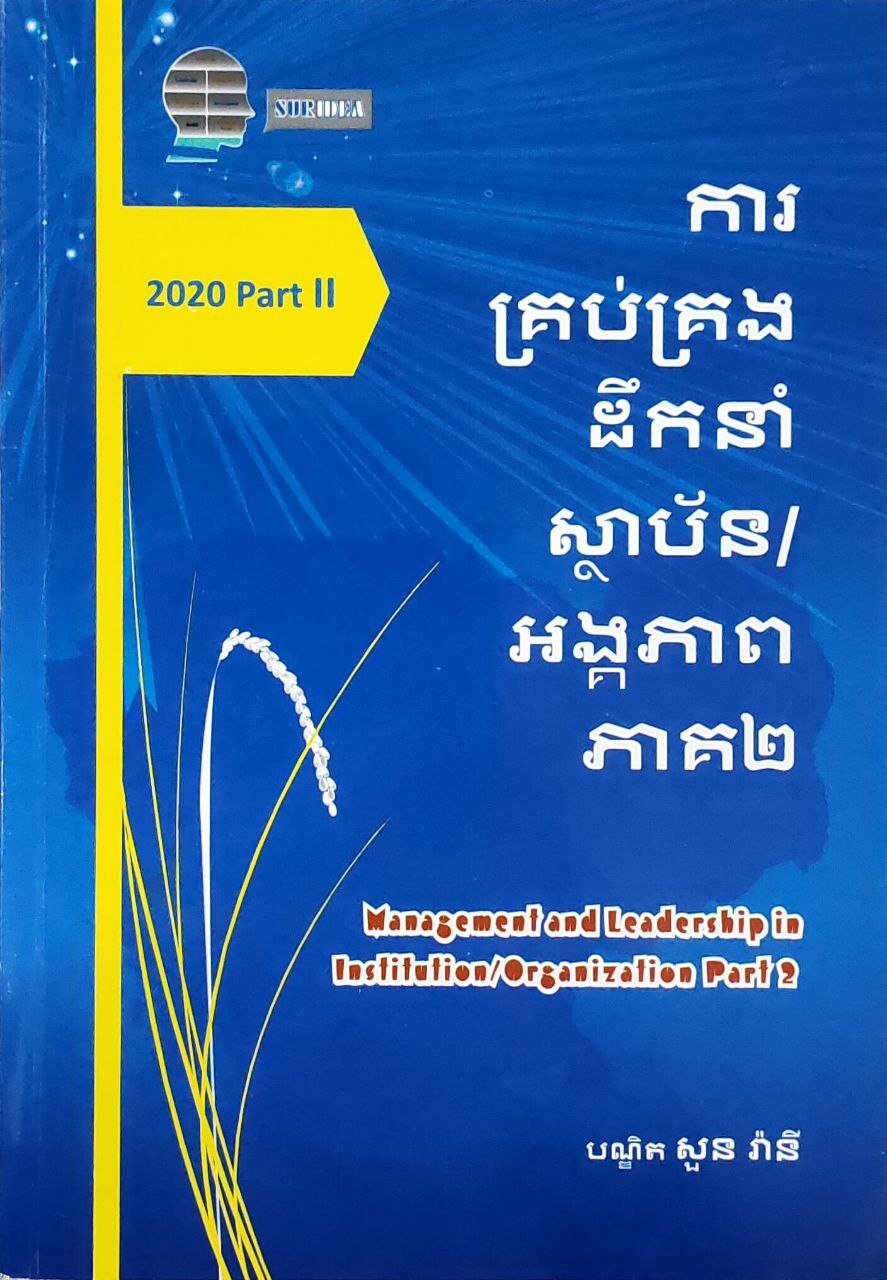
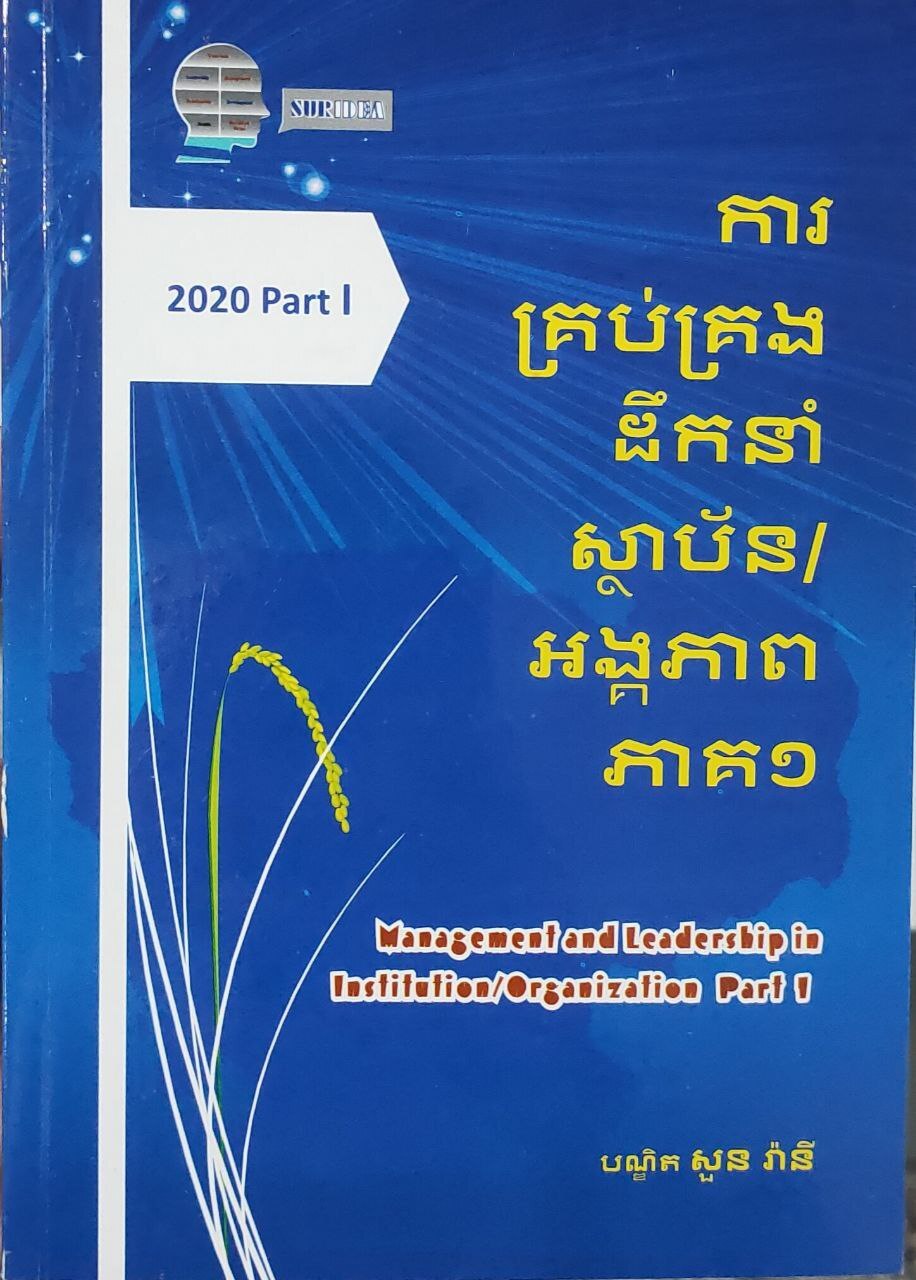
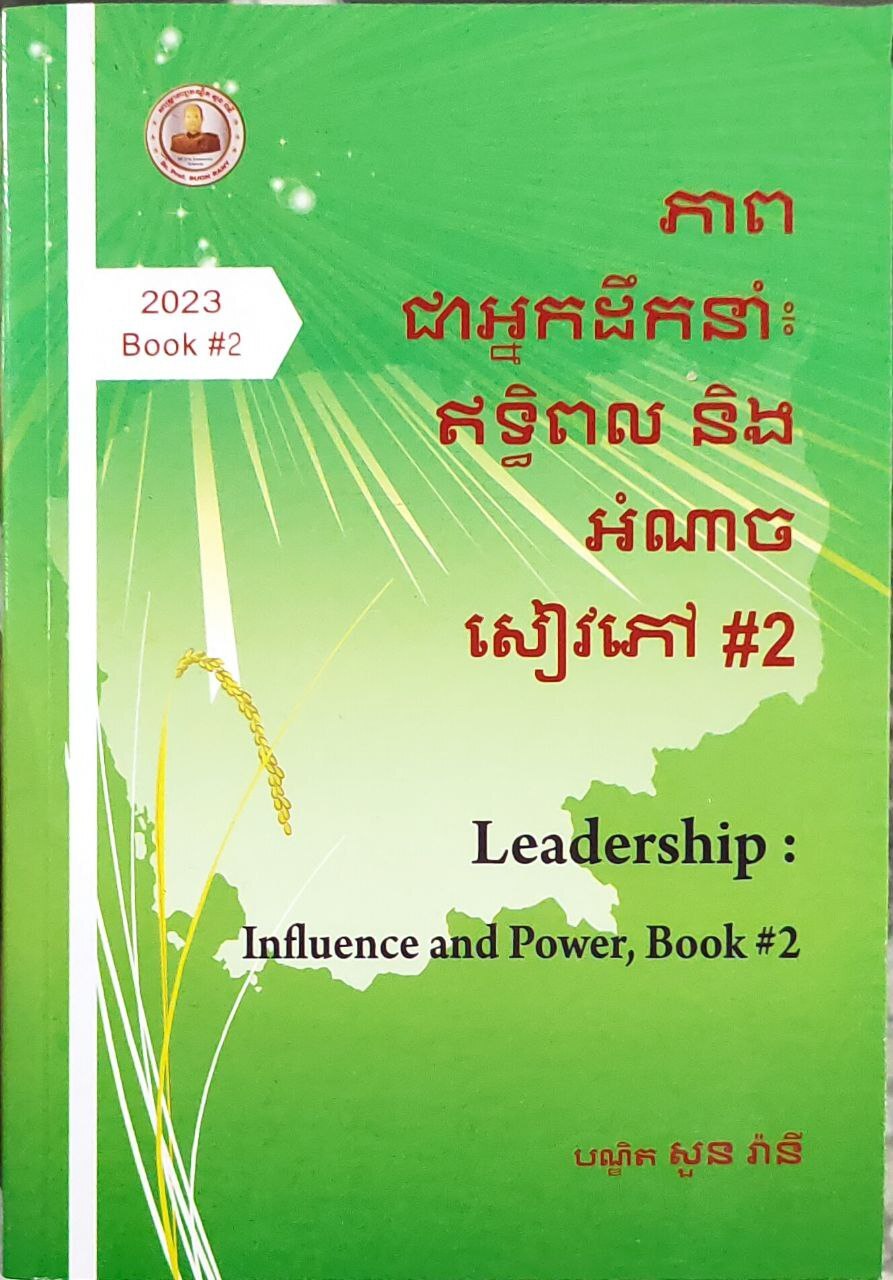
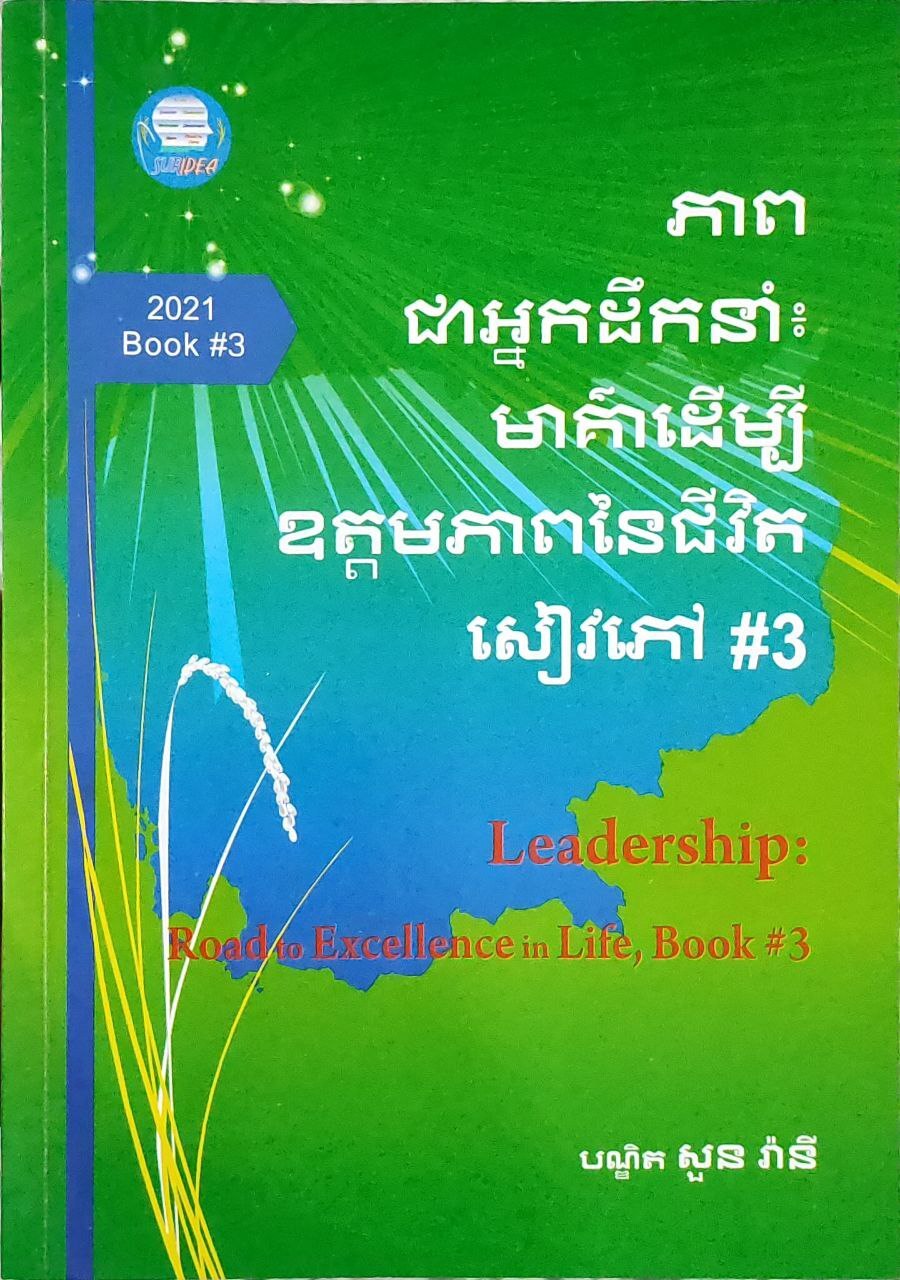
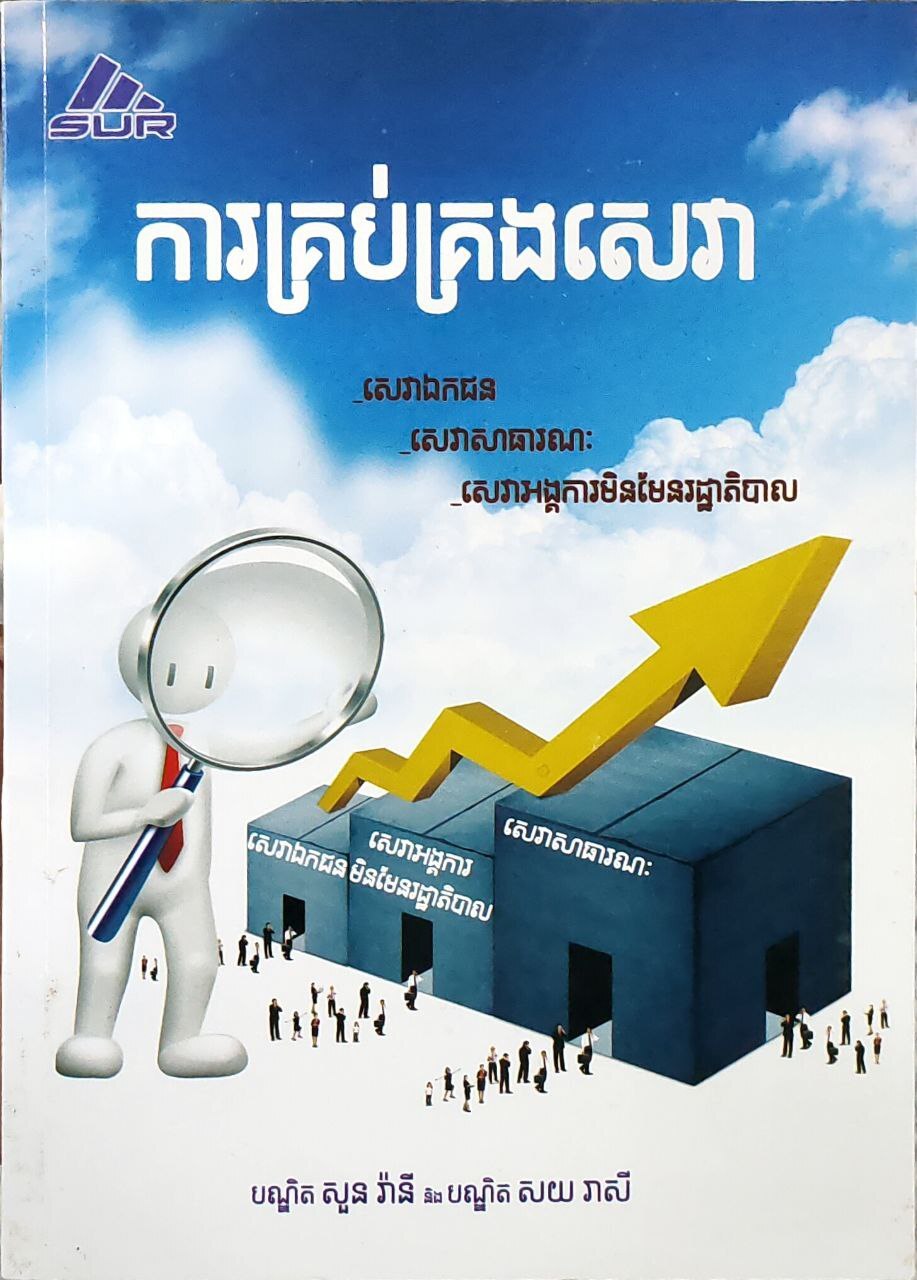
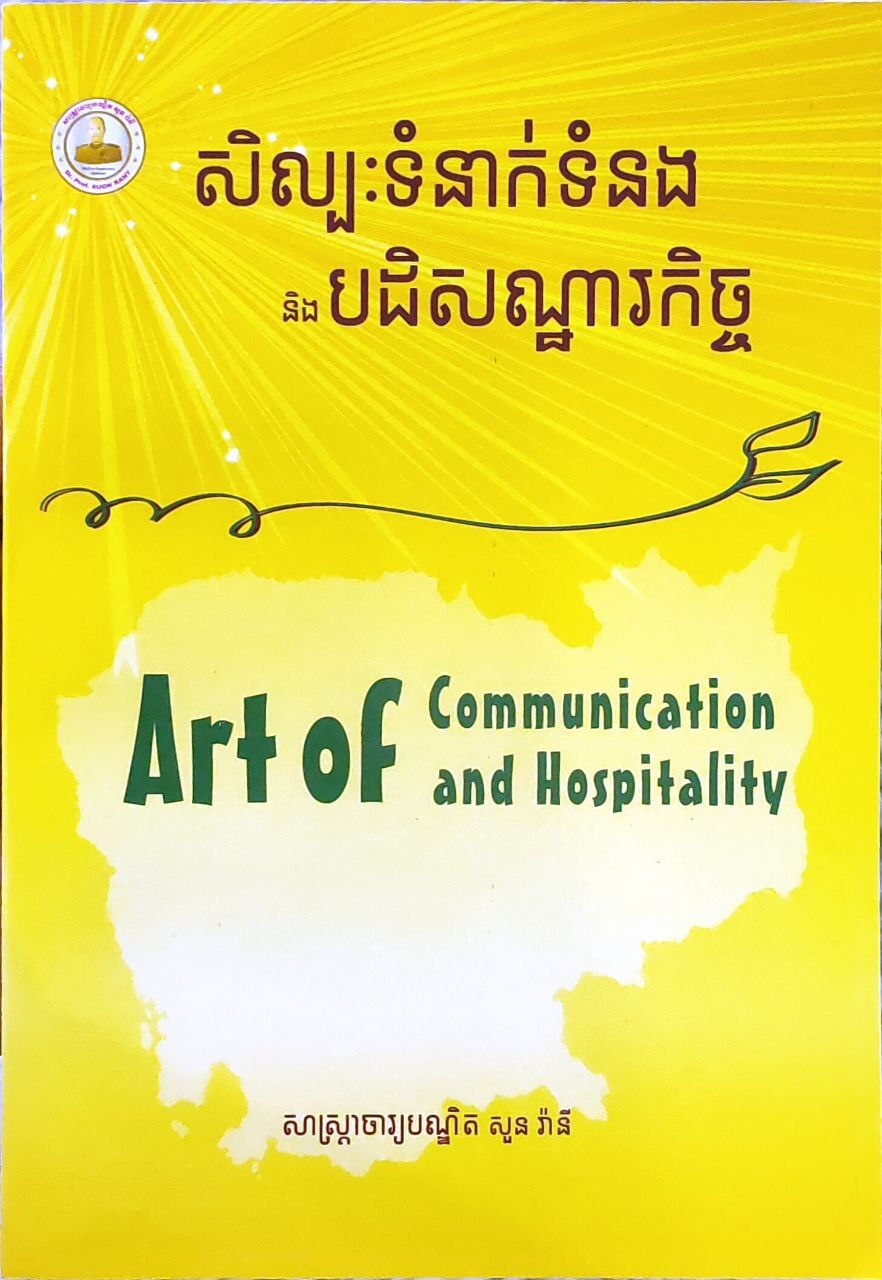
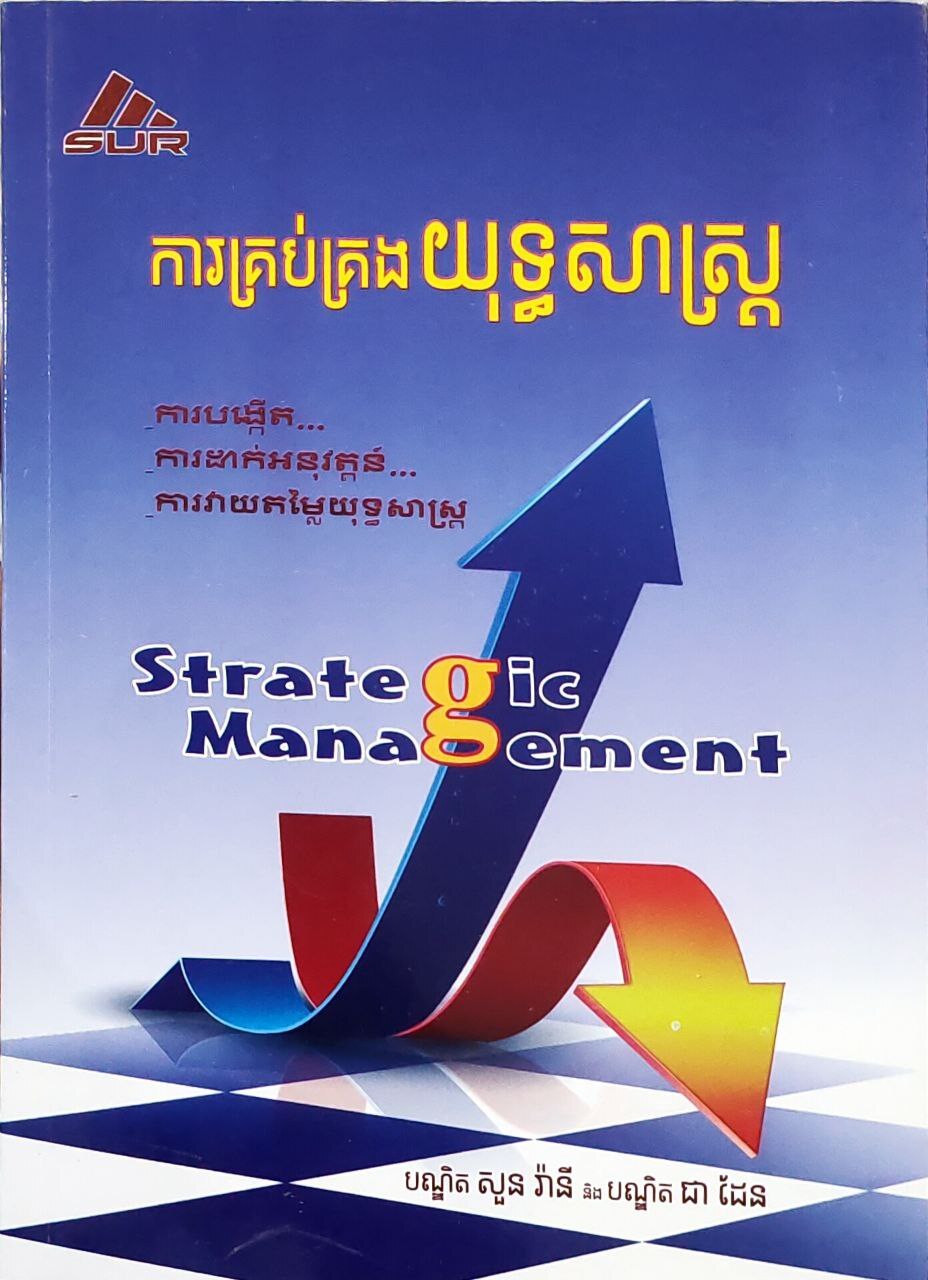
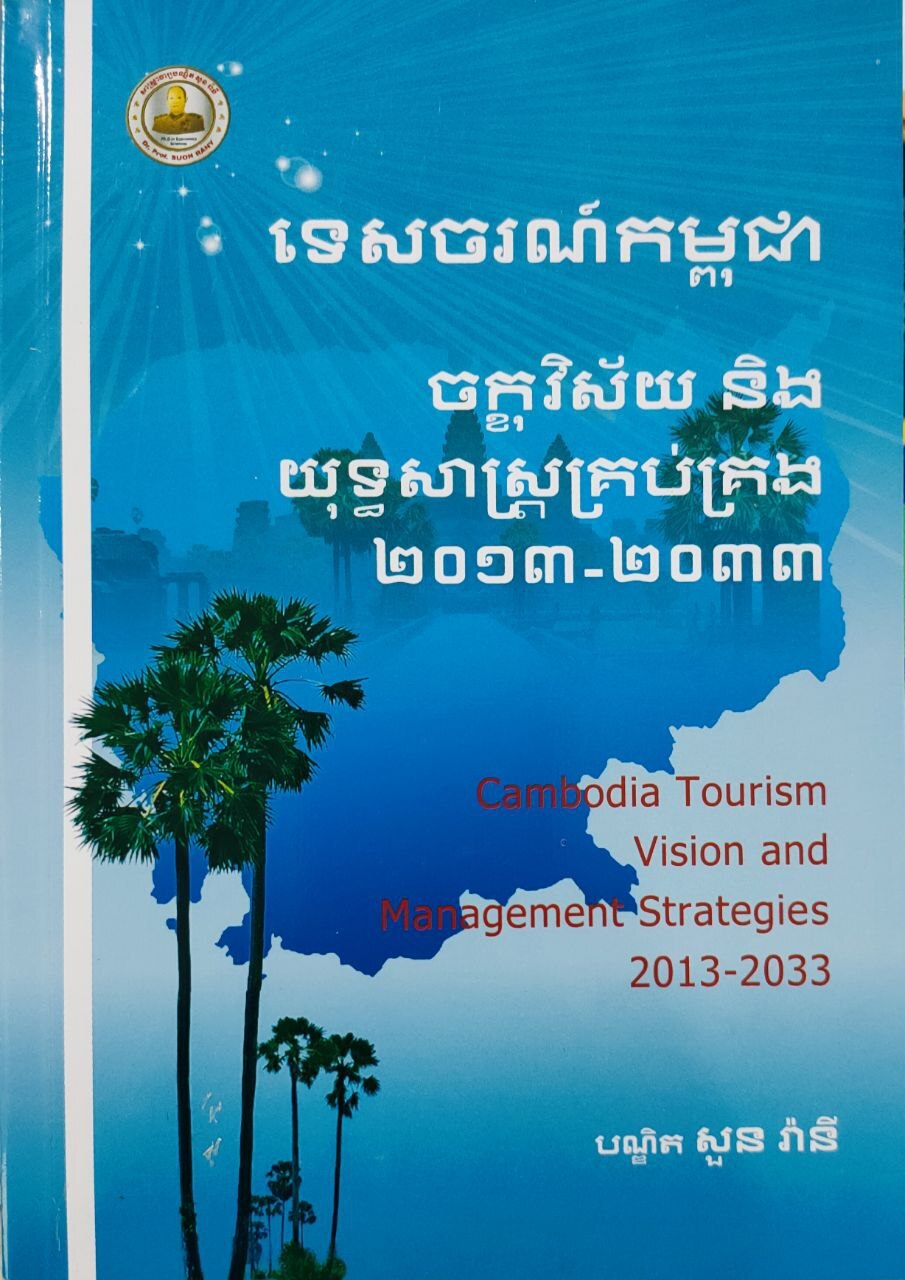

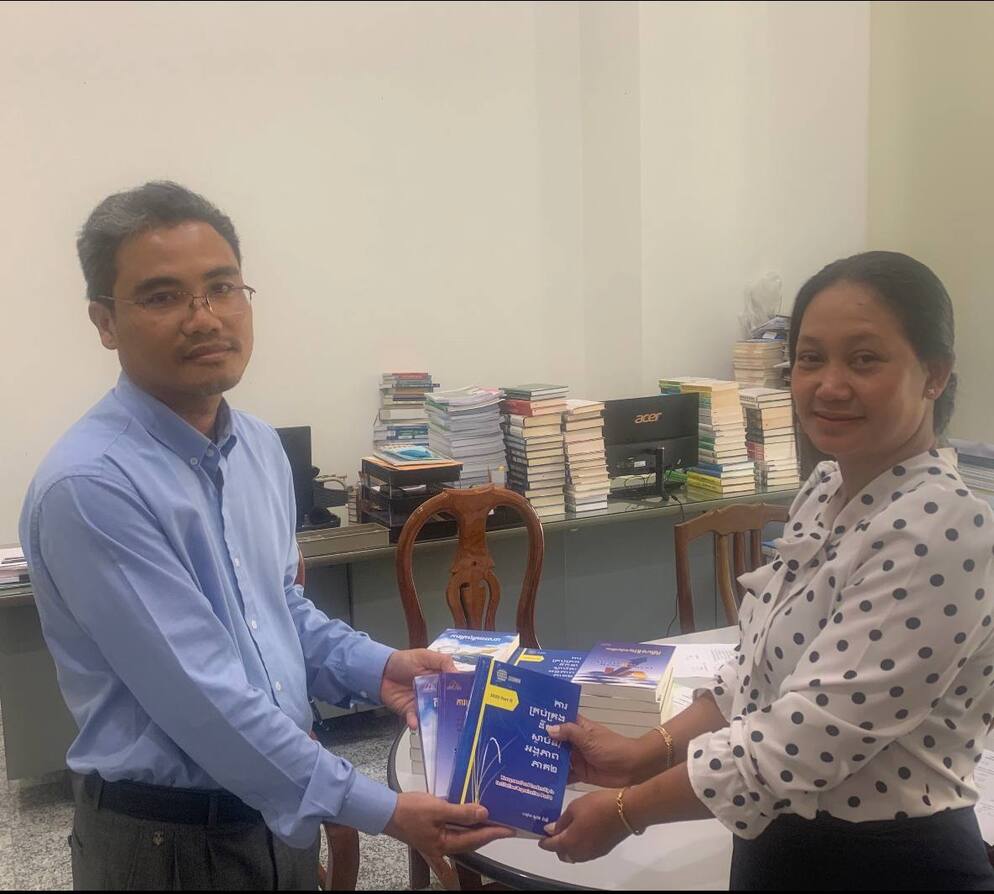
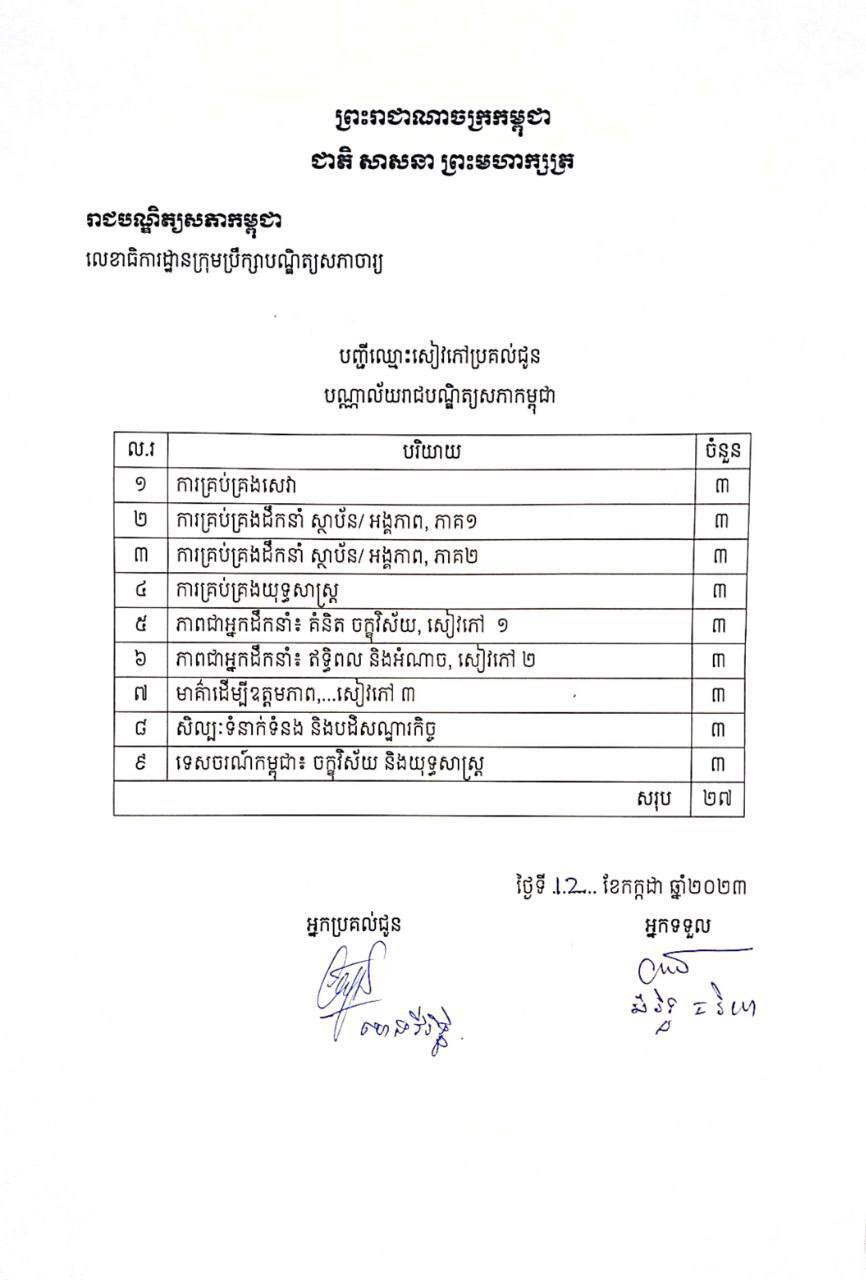
សូមអរគុណ។
 ថ្ងៃពុធ, 12 កក្កដា 2023 ម៉ោង 04:48 PM
ថ្ងៃពុធ, 12 កក្កដា 2023 ម៉ោង 04:48 PM
ជាទូទៅបើគេនិយាយពីធម្មជាតិ នៃការរស់នៅ របស់មនុស្សក្នុងសង្គមគេតែងតែជួបប្រទះនឹងមនុស្សពីរប្រភេទ ដែលមាន ឋានៈសង្គមខុសប្លែកគ្នា ពោលគឺ មនុស្សមួយប្រភេទមានឋានៈជាមេដឹកនាំ ហើយមនុស្សមួយប្រភេទទៀតជាអ្នកនៅក្រោមបង្គាប់។ ជាធម្មតាមនុស្សទាំងពីរប្រភេទនេះតែងរស់នៅជាមួយគ្នា មានទំនាក់ទំនងគ្នា ក្រោមកិច្ចសន្យាសង្គមមួយច្បាស់លាស់។ ដោយឡែក បើគេនិយាយពីបរិមាណវិញ ក៏យ៉ាងនេះដែរ មនុស្សចាប់ពីបីនាក់ឡើងទៅជាក្រឹត្យក្រមត្រូវមានមនុស្សម្នាក់ធ្វើជាមេដឹកនាំ អាស្រ័យទៅលើការស្រុះស្រួលគ្នារបស់អ្នករស់នៅក្នុង ក្រុម។ ដូច្នេះ ទាក់ទងទៅនឹងបញ្ហាមេដឹកនាំ សំណួរអាចចោទសួរឡើងថា តើមេដឹកនាំជានរណា? មានលក្ខណៈវិនិច្ឆ័យបែបណា? មានអ្វីខ្លះទៅជាមុខងារ? ហើយមាននិន្នាការនយោបាយបែបណា? តើកត្ដាអ្វីខ្លះដែល ជម្រុញឱ្យមនុស្សក្លាយទៅជាមេដឹកនាំបាន? ខាងក្រោមនេះគឺជាចម្លើយ ឆ្លើយតបទៅនឹងសំណួរដែលបានចោទឡើងខាងលើ។
សូមចូលអានខ្លឹមសារបន្ថែម និងមានអត្ថបទស្រាវជ្រាវច្រើនទៀតតាមរយៈតំណភ្ជាប់ដូចខាងក្រោម៖
https://rac.gov.kh/researchs-categories/1/researchs?page=6
 ថ្ងៃចន្ទ, 10 កក្កដា 2023 ម៉ោង 09:35 PM
ថ្ងៃចន្ទ, 10 កក្កដា 2023 ម៉ោង 09:35 PM
ស្ថិតនៅភាគខាងជើងប្រទេសកម្ពុជា ក្នុងភូមិសាស្ត្រឃុំស្រអែមស្រុកជាំក្សាន្តខេត្តព្រះវិហារ ប្រាសាទដ៏ចំណាស់មួយដែលមានអាយុជាងមួយពាន់ឆ្នាំ កំពុងឈរបង្អួតរាងយ៉ាងរឹងមាំនៅលើកំពូលភ្នំព្រះវិហារនៃជួរភ្នំដងរែកដែលមានកម្ពស់ប្រមាណ៦២៥ម៉ែត្រពីនីវ៉ូទឹកសមុទ្រ នាំឱ្យមនុស្សម្នាកោតស្ញប់ស្ញែង ចាត់ទុកជាទីសក្ការៈនិងស្គាល់ច្បាស់ថាជាប្រាសាទព្រះវិហារដ៏ពិសិដ្ឋរបស់ខ្មែរគ្រប់ជំនាន់។ កាលសម័យអង្គរ ប្រាសាទព្រះវិហារគឺមានឈ្មោះដើមថាស្រីសិក្ខាគីរីស្វារៈ មានន័យថាជាម្ចាស់នៃកំពូលភ្នំ ហើយក៏ជាឈ្មោះនៅលិង្គថ្មព្រះឥសូរ ដែលស្ដេចជំនាន់មុនយកទៅតម្កល់លើភ្នំនេះ។
តាមការស្រាវជ្រាវពីឯកសារប្រវត្តិសាស្ត្រខ្មែរជាច្រើន ប្រាសាទព្រះវិហារចាប់ផ្ដើមកសាងឡើងក្នុងរជ្ជកាលព្រះបាទសុរិយវរ្ម័នទីមួយនៃគ្រិស្តសករាជឆ្នាំ៨៨៩ ធ្វើឡើងអំពីថ្មភក់នៅលើទីតាំងខ្ពស់មួយនៃជួរភ្នំដងរែក ដែលកាលនោះគឺស្ថិតនៅចំកណ្តាលនៃអតីតទឹកដីមហានគរខ្មែរ ដែលបច្ចុប្បន្នគឺស្ថិតក្នុងទឹកដីខេត្តព្រះវិហារ ជាប់ខេត្តស៊ីសាកេតរបស់ប្រទេសថៃ។ ប្រាសាទព្រះវិហារគឺជាតំបន់ប្រវត្តិសាស្ត្រសាងសង់ក្នុងអំឡុងចុងសតវត្សទី៩ បញ្ចប់ទៅនៅដើមសតវត្សរ៍ទី១២ ក្រោមរជ្ជកាលព្រះបាទសុរិយវរ្ម័នទីពីរនៃសម័យមហានគរ ដើម្បីឧទ្ទិសដល់ព្រះឥសូរដែលជាព្រះអាទិទេពនៅក្នុងព្រហ្មញ្ញសាសនា។
ជាបន្ត យើងខ្ញុំសូមធ្វើការសង្ខេបពីព្រឹត្តិការណ៍ និងកាលបរិច្ឆេទសំខាន់ៗ ដែលកុលបុត្រាបុត្រីកម្ពុជរដ្ឋគប្បីចងចាំឱ្យបានច្បាស់ ដូចខាងក្រោម៖
១- ឆ្នាំ៨៨៩៖ ប្រាសាទព្រះវិហារចាប់ផ្ដើមកសាងឡើងក្នុងរជ្ជកាលព្រះបាទសុរិយវរ្ម័នទីមួយ (សាងសង់ចុងស.វ ទី៩ និងបញ្ចប់ស.វ.ទី១២)។
២- ឆ្នាំ១៩៥៤៖ ប្រាសាទព្រះវិហាររងការឈ្លានពានដណ្ដើមចង់បានជាច្រើនលើកច្រើនសាពីសំណាក់ប្រទេសថៃ ហើយជម្លោះរវាងថៃនិងកម្ពុជា ចាប់ផ្តើមផ្ទុះឡើងខ្លាំង។
៣- ថ្ងៃទី៦ ខែតុលា ឆ្នាំ១៩៥៩៖ កម្ពុជា ដាក់ពាក្យបណ្ដឹងទៅតុលាការយុត្តិធម៌អន្តរជាតិក្រុងឡាអេ ដើម្បីស្នើសុំឱ្យតុលាការប្រគល់អធិបតេយ្យដែនដីប្រាសាទព្រះវិហារមកឱ្យកម្ពុជា និងទាមទារឱ្យថៃដកកងកម្លាំងប្រដាប់អាវុធរបស់ខ្លួនចេញពីតំបន់ប្រាសាទ ក្រោយការតវ៉ាតាមរយៈការទូតជាមួយថៃបរាជ័យ។
៤- ថ្ងៃទី៨ ខែធ្នូ ឆ្នាំ១៩៥៩ សារណារបស់កម្ពុជាត្រូវបានបញ្ជូនទៅដល់ដៃតុលាការតាមពេលកំណត់ តែភាគីថៃវិញបែរជាបញ្ជូនពាក្យបណ្ដឹងមួយបដិសេធមិនទទួលស្គាល់សមត្ថកិច្ចរបស់តុលាការអន្តរជាតិក្នុងការជំនុំជម្រះបណ្ដឹងរបស់កម្ពុជា។
៥- ថ្ងៃទី១០ - ១៥ ខែមេសា ឆ្នាំ១៩៦០៖ សវនការជាសាធារណៈដើម្បីជំនំជម្រះលើបណ្ដឹងជំទាស់របស់ភាគីថៃ។
៦- ថ្ងៃទី២៦ ខែឧសភា ឆ្នាំ១៩៦១ តុលាការយុត្តិធម៌អន្តរជាតិក្រុងឡាអេ បានច្រានចោលបណ្តឹងជំទាស់របស់ភាគីថៃ ដោយប្រកាសជាសាធារណៈថា តុលាការមានសមត្ថកិច្ចពេញលេញក្នុងការដំណើរការអង្គជំនុំជម្រះលើបណ្ដឹងរបស់កម្ពុជា។
៧- ថ្ងៃទី១៥ ខែមិថុនា ឆ្នាំ១៩៦២៖ ប្រាសាទព្រះវិហារត្រូវបានសាលក្រមតុលាការអន្តរជាតិនៃទីក្រុងឡាអេ បានសម្រេចឱ្យភាគីកម្ពុជាឈ្នះក្តីលើប្រាសាទព្រះវិហារ លើភាគីថៃ។
៨- ថ្ងៃទី៧ ខែកក្កដា ឆ្នាំ២០០៨៖ អង្គការយូណេស្កូ បានសម្រេចដាក់ប្រាសាទព្រះវិហាររបស់កម្ពុជា ចូលទៅក្នុងបញ្ជីបេតិកភណ្ឌពិភពលោកក្នុងសម័យប្រជុំលើកទី៣២ នាទីក្រុងកេបិច ប្រទេសកាណាដា ក្រោមសេចក្តីសម្រេច 32 COM 8B. 102 ។
៩- ថ្ងៃទី១០ ខែតុលា ឆ្នាំ២០០១៖ រាជរដ្ឋាភិបាលកម្ពុជា បានស្នើសុំប្រាសាទព្រះវិហារចុះក្នុងបញ្ជីរបស់អង្គការយូណេស្កូ។
១០- ថ្ងៃទី៣០ ខែមិថុនា ឆ្នាំ២០០៦៖ ការបញ្ជូនសំណុំឯកសារសម្រេចទៅមជ្ឈមណ្ឌលបេតិកភណ្ឌពិភពលោកយូណេស្កូ ក្រុងប៉ារីស។
១១- ថ្ងៃទី២៣-២៩ ខែតុលា ឆ្នាំ២០០៦៖ បេសកកម្មបច្ចេកទេសរបស់តំណាងក្រុមប្រឹក្សាអន្តរជាតិ វាយតម្លៃប្រាង្គប្រាសាទ និងរមណីយដ្ឋាន ICOMOS នៅតំបន់ប្រាសាទព្រះវិហារ។
១២- ថ្ងៃទី២១ ខែមករា ឆ្នាំ២០០៧៖ សេចក្ដីយល់ព្រមលើសំណើចុះបញ្ជីដោយ ICOMOS។
១៣- ថ្ងៃទី២៣ ខែមិថុនា - ថ្ងៃទី២ ខែកក្កដា ឆ្នាំ២០០៧៖ កិច្ចប្រជុំលើកទី៣១ របស់គណៈកម្មាធិការបេតិកភណ្ឌពិភពលោ នៅហ្គ្រីសឆឺច (Christchuech) ប្រទេសណូវែលហ្សេឡង់។
១៤- ថ្ងៃទី៧ ខែកក្កដា ឆ្នាំ២០០៨៖ ប្រាសាទព្រះវិហារត្រូវបានចុះបញ្ជីជាសម្បត្តិបេតិកភណ្ឌពិភពលោកក្នុងកិច្ចប្រជុំទី៣២ របស់គណៈកម្មាធិការបេតិកភណ្ឌពិភពលោកនៃអង្គការយូណេស្កូ នៅទីក្រុងកេបិច ប្រទេសកាណាដា។
១៥- ថ្ងៃទី១៥ ខែកក្កដា ឆ្នាំ២០០៨៖ ថៃបានទាហានរបស់ខ្លួនមកឈរជើងនៅក្នុងបរិវេណវត្តកែវសិក្ខាគីរីស្វារៈ ក្បែរតំបន់ប្រាសាទព្រះវិហារ ចម្ងាយប្រមាណ៣០០ម៉ែត្រពីទឹកដីកម្ពុជា។
១៦- ថ្ងៃទី១១ ខែសីហា ឆ្នាំ២០១០៖ កម្ពុជាបានផ្ញើលិខិតទៅអង្គការសហប្រជាជាតិនាក្រុងញ៉ូវយ៉ក ដើម្បីសូមអន្តរាគមន៍អង្គការសហប្រជាជាតិ ឱ្យមានយន្តកម្មអន្តរជាតិ ដើម្បីដោះស្រាយជម្លោះព្រំដែនខ្មែរ-ថៃ មុំជាប់ប្រាសាទព្រះវិហារ។ ថៃបានបង្កើតផែនទីជាឯកតោភាគី មានទំហំ ៤,៦គីឡូម៉ែត្រការ៉េ ជាប់នឹងប្រាសាទព្រះវិហារថាជារបស់ខ្លួន។ ផែនទីនេះខុសបញ្ច្រាស់ទាំងស្រុងពីសាលក្រមតុលាការអន្តរជាតិ ដែលមានន័យថា ប្រាសាទព្រះវិហារស្ថិតលើទឹកដីខ្មែរ និងដែនអធិតេយ្យភាពរបស់កម្ពុជា។
១៧- នៅថ្ងៃទី១១ ខែវិច្ឆិកា ឆ្នាំ២០១៣ តុលាការអាយ.ស៊ី.ជេ បានប្រកាសក្នុងការសម្រេចចិត្តជាឯកច្ឆន្ទ តាមសាលក្រមឆ្នាំ១៩៦២ របស់តុលាការអន្តរជាតិ បានប្រគល់ប្រាសាទព្រះវិហារទាំងអស់ ឱ្យមកកម្ពុជា ហើយភាគីថៃមានកាតព្វកិច្ចត្រូវតែដកកងទ័ព ប៉ូលិស ឬឆ្មាំថៃដែលឈរជើងក្នុងតំបន់ប្រាសាទព្រះវិហារទាំងអស់ដោយគ្មានលក្ខខណ្ឌ។
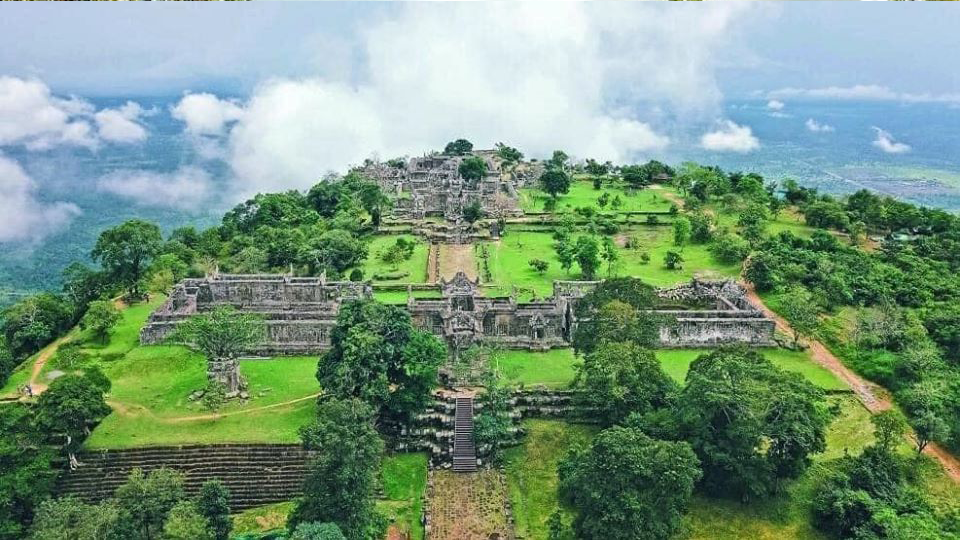
តាមរយៈសិលាចារឹកដែលមានឆ្លាក់ចារនៅលើប្រាសាទបាពួន សិលាចារឹក K-583 បានចារថា មានព្រះអង្គម្ចាស់មួយអង្គព្រះនាមឥន្ទ្រាយុទ្ធ ជាក្សត្រដែលខ្លាំងពូកែ អាចច្បាំងយកជ័យជម្នះលើស្ដេចចាមបាននោះ ទ្រង់ជាក្សត្រដែលបានយកលិង្គថ្មធម្មជាតិមួយ ឈ្មោះស្រីសិខវិស្វរៈ មកតាំងនឹងមកប្រតិស្ថានលើប្រាសាទព្រះវិហារ។
បើតាមអត្ថបទសិលាចារឹកនៅប្រាសាទព្រះវិហារលើ K-581 ចារជាភាសាខ្មែរបុរាណនិងជាភាសាសំស្ក្រឹត ប្រវត្តិប្រាសាទដ៏ពិសិដ្ឋរបស់ខ្មែរមួយនេះ គឺមានទំនាក់ទំនងជាមួយព្រាហ្មណ៍ម្នាក់ឈ្មោះថា តៈបៈស្វិន្រ្ទបណ្ឌិត។ ព្រាហ្មណ៍តៈបៈស្វិន្ទ្របណ្ឌិត មានអាស្រមមួយនៅនឹងដែនដីនៃទីតាំងប្រាសាទព្រះវិហារ។ នៅអំឡុងឆ្នាំ១០២៤ នៃគ្រិស្ដសករាជ ព្រាហ្មណ៍នោះបានទទួលអង្រឹងស្នែងមាសនិងវត្ថុដ៏មានតម្លៃដទៃទៀតជាច្រើនពីព្រះបាទសុរិយវរ្ម័នទីមួយ ដែលជាការដឹងគុណពីព្រះអង្គចំពោះព្រាហ្មណ៍តបស្វិន្ទ្របណ្ឌិតក្នុងការថែរក្សាលិង្គព្រះអទិទេព។ នៅលើសិលាចារឹក មានបញ្ជាក់ទៀតថា ព្រះបាទសុរិយវរ្ម័នទីមួយជាក្សត្រមានជំនឿខ្លាំងណាស់លើលិង្គអាទិទេពមួយអង្គនេះ ហើយកំណត់ត្រាសិលាចារឹកបញ្ជាក់ច្បាស់ៗថា សីវលិង្គនេះតែងតែសម្ដែងមហិទ្ធិឫទ្ធិបដិហារឱ្យព្រះអង្គបានទត។ ក្នុងបរិវេណប្រាសាទ មានស្រះទឹកបុរាណមួយមានទីតាំងស្ថិតនៅខាងឆ្វេងព្រះថ្នល់ ចន្លោះគោបុរៈទី៤ និងគោបុរៈទី៥ ទទឹងប្រវែង១៦,៨០ម៉ែត្រ និងបណ្ដោយ៣៧,៨០ម៉ែត្រ។ បើតាមតំណាលតៗគ្នាមកល្បីថា ស្រះទឹកនេះជាទឹកមន្តស័ក្តិសិទ្ធិអស្ចារ្យសម្រាប់យកទៅប្រើប្រាស់ពិធីសក្ការៈផ្សេងៗ ហើយសូម្បីតែអតីតព្រះមហាក្សត្រថៃ ព្រះបាទភូមិបុលអាឌុលយ៉ាដេត ធ្លាប់បានប្រើទឹកពីស្រះនេះ ដើម្បីបំពេញពិធីអភិសេកឡើងគ្រងរាជសម្បត្តិកាលពីថ្ងៃទី៩ ខែមិថុនា ឆ្នាំ១៩៤៦ ផងដែរ។
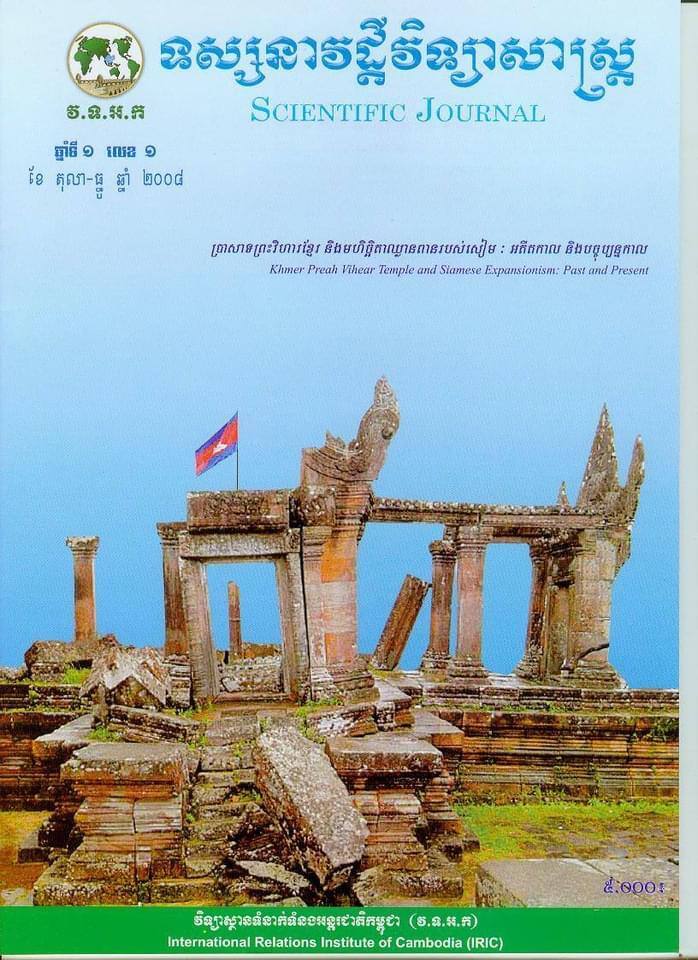
ប្រាសាទព្រះវិហាររងការឈ្លានពានដណ្ដើមចង់បានជាច្រើនលើកច្រើនសាពីសំណាក់ប្រទេសថៃ ហើយជម្លោះរវាងថៃនិងកម្ពុជា ចាប់ផ្តើមផ្ទុះឡើងខ្លាំងក្នុងឆ្នាំ១៩៥៤ បន្ទាប់ពីកម្ពុជាទទួលបានឯករាជ្យពីបារាំងដោយថៃក៏បានបញ្ជូនកងកម្លាំងប្រដាប់អាវុធចូលមកកាន់ប្រាសាទព្រះវិហារទាំងគឃ្លើន។ រដ្ឋាភិបាលកម្ពុជាពេលនោះ ដែលមានព្រះបាទសម្ដេចព្រះនរោត្តម សីហនុ ព្រះបរមរតនកោដិ ជាប្រមុខរដ្ឋ បានដឹកនាំកម្ពុជាបើកដំណើរការទាមទារកម្មសិទ្ធិតាមរយៈការទូតជាមួយថៃ ប៉ុន្តែត្រូវបរាជ័យនាំឱ្យកម្ពុជាងាកទៅរកយន្តការតុលាការវិញម្ដង ដោយបានដាក់ពាក្យបណ្ដឹងទៅតុលាការយុត្តិធម៌អន្តរជាតិក្រុងឡាអេ នៅថ្ងៃទី៦ ខែតុលា ឆ្នាំ១៩៥៩ ដើម្បីស្នើសុំឱ្យតុលាការប្រគល់អធិបតេយ្យដែនដីប្រាសាទព្រះវិហារមកឱ្យកម្ពុជា និងទាមទារឱ្យថៃដកកងកម្លាំងប្រដាប់អាវុធរបស់ខ្លួនចេញពីតំបន់ប្រាសាទ។ នៅថ្ងៃទី៨ ខែធ្នូ ឆ្នាំ១៩៥៩ សារណារបស់កម្ពុជាត្រូវបានបញ្ជូនទៅដល់ដៃតុលាការតាមពេលកំណត់ តែភាគីថៃវិញបែរជាបញ្ជូនពាក្យបណ្ដឹងមួយបដិសេធមិនទទួលស្គាល់សមត្ថកិច្ចរបស់តុលាការអន្តរជាតិក្នុងការជំនុំជម្រះបណ្ដឹងរបស់កម្ពុជាទៅវិញ។
សវនការជាសាធារណៈដើម្បីជំនំជម្រះលើបណ្ដឹងជំទាស់របស់ភាគីថៃ ត្រូវបានបើកធ្វើឡើងចាប់ពីថ្ងៃទី១០ រហូតដល់ថ្ងៃទី១៥ ខែមេសា ឆ្នាំ១៩៦០ ហើយថ្ងៃទី២៦ ខែឧសភា ឆ្នាំ១៩៦១ តុលាការយុត្តិធម៌អន្តរជាតិក្រុងឡាអេ បានច្រានចោលបណ្តឹងជំទាស់របស់ភាគីថៃ ដោយប្រកាសជាសាធារណៈថា តុលាការមានសមត្ថកិច្ចពេញលេញក្នុងការដំណើរការអង្គជំនុំជម្រះលើបណ្ដឹងរបស់កម្ពុជា។ តាមរយៈបន្ទាត់ព្រំដែននៅក្នុងផែនទីឧបសម្ព័ន្ធទីមួយ ដែលគេធ្វើឡើងរវាងបារាំងសៀម ក្នុងសន្ធិសញ្ញាឆ្នាំ១៩០៤ បង្ហាញថាប្រាសាទព្រះវិហារស្ថិតនៅក្នុងទឹកដីកម្ពុជាយ៉ាងពិតប្រាកដ ដោយថ្ងៃទី១៥ មិថុនា ឆ្នាំ១៩៦២ ប្រាសាទព្រះវិហារត្រូវតុលាការអន្តរជាតិក្រុងឡាអេ សម្រេចសាលក្រមប្រគល់ឱ្យភាគីកម្ពុជា ជាអ្នកឈ្នះក្តីរឿងវិវាទកម្ពុជាថៃ។
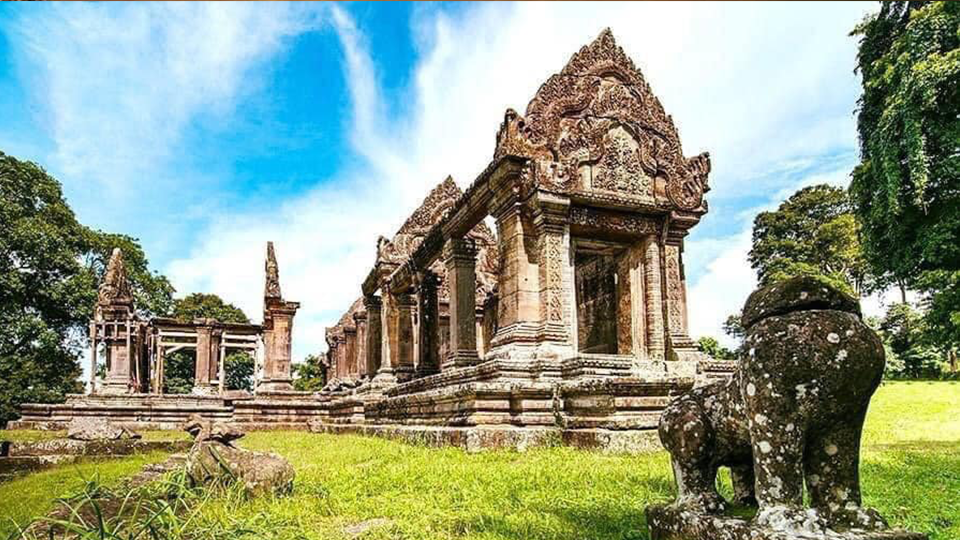
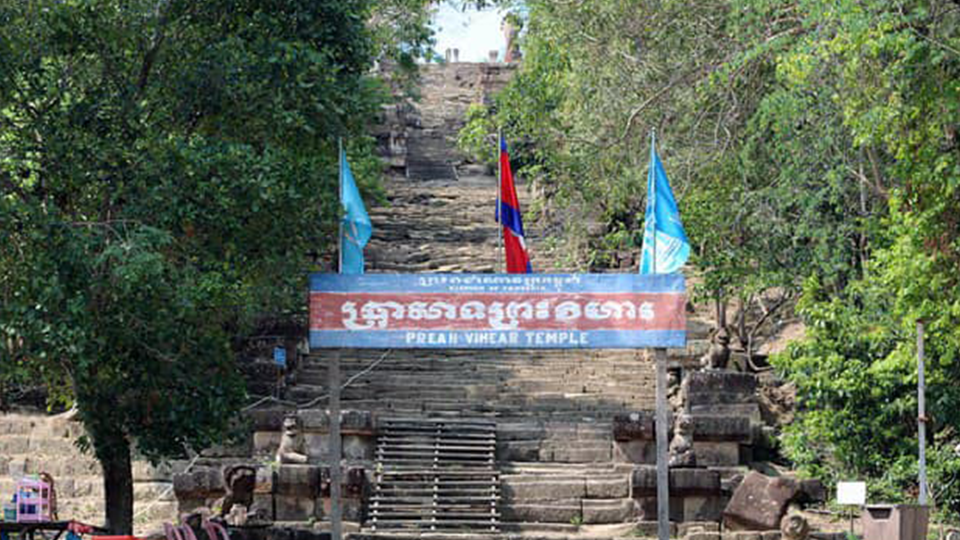

ប្រាសាទដ៏ពិសិដ្ឋរបស់កម្ពុជាមួយនេះ ត្រូវបានចុះបញ្ជីជាសម្បត្តិបេតិកភណ្ឌពិភពលោកក្នុងកិច្ចប្រជុំទី៣២ របស់គណៈកម្មាធិការបេតិកភណ្ឌពិភពលោកនៃអង្គការយូណេស្កូ នាថ្ងៃទី៧ ខែកក្កដា ឆ្នាំ២០០៨ ធ្វើឡើងនៅទីក្រុងកេបិចប្រទេសកាណាដា។ វិវាទព្រំដែនកម្ពុជាថៃនៅតំបន់ប្រាសាទព្រះវិហារ ចាប់ផ្ដើមផ្ទុះជាថ្មីអំឡុងខែមិថុនា ឆ្នាំ២០០៨ ជាពេលដែលប្រាសាទព្រះវិហារស្ថិតក្នុងការពិចារណាដាក់បញ្ចូលជាសម្បត្តិបេតិកភណ្ឌពិភពលោក ដោយនៅថ្ងៃទី១៥ ខែកក្កដា ឆ្នាំ២០០៨ ថៃបានទាហានរបស់ខ្លួនមកឈរជើងនៅក្នុងបរិវេណវត្តកែវសិក្ខាគីរីស្វារៈ ក្បែរតំបន់ប្រាសាទព្រះវិហារ ចម្ងាយប្រមាណ៣០០ម៉ែត្រពីទឹកដីកម្ពុជា។ វិវាទនេះបានបង្កឱ្យមានការប៉ះទង្គិចផ្នែកយោធារវាងប្រទេសទាំងពីរ នឹងបង្កជាក្ដីក្ដាំជាថ្មីនៅលើតុលាការអន្តរជាតិអាយ.ស៊ី.ជេ។ រហូតដល់ខែធ្នូ ឆ្នាំពី២០១១ កិច្ចព្រមព្រៀងមួយ ត្រូវបានធ្វើឡើងដើម្បីដកកងទ័ពចេញពីតំបន់ជម្លោះ។ នៅថ្ងៃទី១១ ខែវិច្ឆិកា ឆ្នាំ២០១៣ តុលាការអាយ.ស៊ី.ជេ បានប្រកាសក្នុងការសម្រេចចិត្តជាឯកច្ឆន្ទ តាមសាលក្រមឆ្នាំ១៩៦២ របស់តុលាការអន្តរជាតិ បានប្រគល់ប្រាសាទព្រះវិហារទាំងអស់ ឱ្យមកកម្ពុជា ហើយភាគីថៃមានកាតព្វកិច្ចត្រូវតែដកកងទ័ព ប៉ូលិស ឬឆ្មាំថៃដែលឈរជើងក្នុងតំបន់ប្រាសាទព្រះវិហារទាំងអស់ដោយគ្មានលក្ខខណ្ឌ។
 ថ្ងៃសុក្រ, 07 កក្កដា 2023 ម៉ោង 02:23 PM
ថ្ងៃសុក្រ, 07 កក្កដា 2023 ម៉ោង 02:23 PM
ព្រះពុទ្ធសាសនាមានដើមកំណើតនៅ ប្រទេសឥណ្ឌាក្នុងសតវត្សរ៍ទី ៦ មុនគ.ស ប្រហែលគ្នានឹងសម័យទី២ នៃលទ្ធិសាសនាព្រាហ្មណ៍ ដោយព្រះសិទ្ធត្ថជាព្រះបុត្រានៃមហាក្សត្រព្រះអង្គបានត្រាស់ដឹងនូវព្រះធម៌ ហើយមានសង្ឃសាវ័កកាន់តែច្រើនបានដើរតាមមាគ៌ាជីវិតតាមព្រះអង្គ។ រហូតពេលបច្ចុប្បន្ន ពុទ្ធសាសនា ជាសាសនាមួយសំខាន់ក្នុងចំណោមសាសនាធំៗទាំងឡាយ នៅលើពិភពលោក។ ពុទ្ធសាសនាបាននិងកំពុងពង្រឹងអត្ថិភាពរបស់ខ្លួនយ៉ាងសកម្មតាមរយៈផ្សព្វផ្សាយមូលដ្ឋានគ្រឹះរបស់ខ្លួន។ តើអ្វីខ្លះជាមូលដ្ឋានគ្រឹះដ៏សំខាន់របស់ពុទ្ធសាសនា? ចម្លើយដ៏សាមញ្ញបំផុតទៅ នឹងសំណួរនេះគឺ៖ រតនត្រ័យ មានព្រះពុទ្ធ ព្រះធម៌ និង ព្រះសង្ឃ ។
សូមចូលអានខ្លឹមសារលម្អិត និងមានអត្ថបទច្រើនទៀតតាមរយៈតំណភ្ជាប់ដូចខាងក្រោម៖
https://rac.gov.kh/researchs-categories/1/researchs?page=6
 ថ្ងៃព្រហស្បតិ៍, 06 កក្កដា 2023 ម៉ោង 09:26 PM
ថ្ងៃព្រហស្បតិ៍, 06 កក្កដា 2023 ម៉ោង 09:26 PM
The high-ranking team of the Republic of Korea (RoK), led by President Yoon Suk Yeol, recently traveled to Vietnam, which is a neighboring country of Cambodia. President Yoon participated in a number of significant activities during the visit, including paying respects to the late Vietnamese President Ho Chi Minh at his mausoleum in Hanoi, paying a visit to Party General Secretary Nguyen Phu Trong, attending an official welcome ceremony with a 21-gun salute, speaking with President Thuong, attending a press conference with him, and witnessing the exchange of numerous cooperation documents.
Vietnam is seen as having a highly wise foreign policy because it is able to maintain cordial ties with all nations, including the US, Russia, Japan, the EU, Australia, and South Korea. The media frequently covers the tension between China and Vietnam related to the issues of the South China Sea, however, both nations assert that their relations are cordial and that there are many Chinese companies operating in Vietnam.
The primary foreign policy and strategies of Vietnam to entice South Korea (and other nations) to be partners can be summed up in the following eight points;
1. Business-friendly policies and regulations: Vietnam can continue to streamline its regulatory framework, making it more transparent and investor-friendly. Ensuring clear and efficient business processes, reducing bureaucracy, and simplifying administrative procedures can all contribute to creating a favorable investment environment.
2. Investment incentives: Offering attractive investment incentives can be a powerful motivating factor for South Korean companies to invest in Vietnam. Tax incentives, duty exemptions, and preferential treatment for specific industries or regions can encourage investment. Vietnam can also consider providing support in terms of land access, infrastructure development, and special economic zones.
3. Market access: Vietnam's growing middle class and expanding consumer market make it an appealing destination for South Korean businesses. Vietnam can highlight the access it provides to the ASEAN market, which encompasses a population of over 650 million people. By positioning itself as a gateway to Southeast Asia, Vietnam can attract South Korean companies seeking regional expansion opportunities.
4. Infrastructure development: Vietnam can invest in enhancing its infrastructure, such as roads, ports, airports, and digital connectivity. Efficient transportation networks and well-developed logistics capabilities are crucial factors for businesses considering investment. South Korean companies with expertise in infrastructure development can be encouraged to participate in these projects.
5. Skilled workforce and talent development: Vietnam can continue to invest in education and training programs to develop a skilled workforce. By focusing on vocational training, technical education, and language skills (including Korean language programs), Vietnam can offer a competitive advantage to South Korean companies looking for a capable workforce.
6. Technology transfer and innovation collaboration: Promoting technology transfer and collaboration between South Korean and Vietnamese companies can be mutually beneficial. Encouraging joint ventures, research collaborations, and knowledge-sharing initiatives can facilitate skills and technology transfer, enabling Vietnam to accelerate its industrial and innovation capabilities.
7. Networking and business matchmaking: Vietnam can organize trade fairs, exhibitions, and business matchmaking events to connect South Korean investors with local businesses and potential partners. Facilitating networking opportunities can foster relationships and build trust between Vietnamese and South Korean companies.
8. Promote success stories: Highlighting successful South Korean investments in Vietnam and their positive outcomes can showcase the country's potential and instill confidence in other South Korean investors. Sharing testimonials and success stories can help attract more interest and investment.
It's important for Vietnam to consistently promote its business advantages, actively engage with potential investors, and maintain a business-friendly environment to successfully attract South Korean investment.
If the Kingdom of Cambodia really want to become a good partner of South Korea, it can adopt several strategies, similar to what Vietnam has done. Here are some suggestions;
1. Enhance diplomatic relations: Cambodia could actively engage in diplomatic dialogue with South Korea, participating in regular meetings and discussions to strengthen bilateral ties. The countries can also exchange high-level visits by government officials to foster better understanding and cooperation.
2. Promote trade and investment: Cambodia can work on improving its business environment by streamlining regulations and offering favorable incentives to attract South Korean investors. By promoting trade fairs, exhibitions, and business matchmaking events, Cambodia can encourage South Korean businesses to explore opportunities and invest in various sectors in the country. All Cambodian diplomats abroad should be more active and exhibit the good things about Cambodia to attract more foreign investors to come to Cambodia.
3. Develop infrastructure: Cambodia could invest in developing its infrastructure, such as transportation networks, energy supply, and digital connectivity. This would improve the ease of doing business and facilitate trade between the two countries. South Korean companies, known for their expertise in infrastructure development, could be invited to participate in these projects.
4. Enhance educational and cultural exchanges: Cambodia can encourage student exchanges and collaboration between educational institutions in both countries. Establishing scholarships or joint research programs can provide opportunities for students and scholars to learn from each other. Cultural events, such as festivals, exhibitions, and performances, can foster mutual understanding and appreciation for each other's heritage.
5. Strengthen tourism cooperation: Cambodia could target South Korean tourists by showcasing its unique cultural and natural attractions. Promoting Cambodia's rich history, UNESCO World Heritage sites, and ecotourism destinations through targeted marketing campaigns can attract more South Korean visitors. Additionally, improving air connectivity and facilitating travel arrangements can make it easier for tourists to choose Cambodia as their preferred destination.
6. Collaborate in technology and innovation: Cambodia can seek partnerships with South Korean companies and institutions in areas like information technology, advanced manufacturing, and research and development. Encouraging technology transfer, joint ventures, and research collaborations can help Cambodia acquire technological expertise and boost its industrial and innovation capabilities.
Overall, by actively engaging in trade, investment, education, cultural exchanges, and infrastructure development, Cambodia can establish itself as a valuable partner to South Korea, similar to Vietnam. It's important to consistently promote mutual interests and showcase the benefits of collaboration in order to strengthen the bilateral relationship.
---------------
Dr. Seun Sam is a Policy Analyst of the Royal Academy of Cambodia.
 ថ្ងៃពុធ, 05 កក្កដា 2023 ម៉ោង 09:26 PM
ថ្ងៃពុធ, 05 កក្កដា 2023 ម៉ោង 09:26 PM
កាលពីថ្ងៃទី២៤ ខែមិថុនា ឆ្នាំ២០២៣ រដ្ឋាភិបាលមូស្គូ (Moscow) បានប្រកាសចាត់វិធានការប្រឆាំងភេរវកម្មដោយបានហាមមិនអនុញ្ញាតឱ្យប្រជាពលរដ្ឋចេញពីផ្ទះឡើយ ក្រោយពេល ក្រុមទាហានស៊ីឈ្នួល វ៉ាក់ណែ (Wagner) បានលើកទ័ពចេញពីទឹកដីអ៊ុយក្រែន រួចបែរចុងកាណុងតម្រង់ឆ្ពោះទៅកាន់ទីក្រុង Moscow។ ការណ៍នេះ នាំឱ្យពិភពលោក ពិសេសអ្នកតាមដានព្រឹត្តិការណ៍អន្តរជាតិហាក់មានការយកចិត្តទុកដាក់យ៉ាងខ្លាំង ព្រមទាំងមានការចោទសួរយ៉ាងខ្លាំងពីសំណាក់សាធារណជន អ្នកតាមដានព្រឹត្តិការណ៍អន្តរជាតិ ក៏ដូចជាក្នុងស្រទាប់អ្នកសិក្សាស្រាវជ្រាវ ព្រោះថាក្រុមទាហានស៊ីឈ្នួលWagner គឺជាដៃគូប្រយុទ្ធដ៏សំខាន់របស់កងទ័ពរុស្ស៊ីនៅក្នុងសមរភូមិអ៊ុយក្រែននេះ ហើយជាពិសេសនៅតំបន់ភាគខាងកើតអ៊ុយក្រែនតែម្តង។
ម្យ៉ាងវិញទៀត ក្រុមទាហានស៊ីឈ្នួលWagner ក៏បានទទួលអាវុធពីកងទ័ពរុស្ស៊ី ដើម្បីប្រយុទ្ធនៅអ៊ុយក្រែនថែមទៀតផង។ ផ្ទុយទៅវិញ នៅដំណាក់កាលចុងក្រោយនេះ ស្ថានការណ៍បានឈានទៅដល់បរិបទថ្មី ព្រោះគេពិតជាមិននឹកស្មានដល់ថា ក្រុមទាហានស៊ីឈ្នួលរុស្ស៊ី Wagner អាចងាកមកចាក់ពីក្រោយខ្នងរុស្ស៊ីវិញនោះឡើយ។
ដូច្នេះ តើក្រុម Wagner និងរុស្ស៊ីមានទំនាក់ទំនងគ្នាស្អិតរមួត និងល្អូកល្អឿននឹងគ្នាដល់កម្រិតណា? ហើយតើមានដើមចមអ្វីខ្លះទើបធ្វើឱ្យ Wagner និងរុស្ស៊ីឈានដល់ដំណាក់កាលចែកផ្លូវគ្នាយ៉ាងនេះ?
សូមចូលអានខ្លឹមសារលម្អិត និងមានអត្ថបទស្រាវជ្រាវច្រើនទៀតតាមរយៈតំណភ្ជាប់ដូចខាងក្រម៖
http://rac.gov.kh/researchs-categories/10/researchs?page=2
 ថ្ងៃអង្គារ, 04 កក្កដា 2023 ម៉ោង 11:34 AM
ថ្ងៃអង្គារ, 04 កក្កដា 2023 ម៉ោង 11:34 AM
Japan and South Korea share a protracted and complicated history of hostility. Following Japan's 1910–1945 rule of Korea, which included forced labor and sexual slavery, tensions increased. Both nations have worked hard in recent years to put their difficult past behind them and forge stronger ties. However, there have been a number of obstacles, including disputes over territorial claims and business-related difficulties. This article will look at the history of the connection between South Korea and Japan, the difficulties that have emerged, and the potential future for these two countries to forge a friendly and mutually beneficial partnership.
The long-standing animosity between South Korea and Japan
A long-standing enmity between South Korea and Japan that extends back to the early 20th century has complicated their relationship. The colonization on Korea by Japan between 1910 and 1945, which was characterized by violent persecution, forced labor, and other violations of human rights, can be linked to the origins of this hostility[1].
Following World War II, Japan made amends for its deeds, made restitution, and the two nations established diplomatic ties. The relationship between the two nations has remained tense since the past's wounds have not completely healed.
The topic of "comfort women" a euphemism used to denote women who were forced into sexual slavery by the Japanese military during World War II, is one of the major issues of dispute between the two nations. A more sincere apology from Japan as well as financial support for the victims have been asked by South Korea [2].
Other difficulties include debates about how a group of tiny islands should be portrayed in school textbooks and territorial conflicts over that nation. While there have been efforts to repair relations between South Korea and Japan, such as the signing of a treaty in 2015 intended to resolve the issue of the "comfort women," progress has been slow and both sides continue to harbor mistrust of one another[3].
It will take a concerted effort from both nations to acknowledge the past, resolve remaining issues, and strive toward a future of mutual respect and understanding in order to overcome this historical hatred.
The roots of the conflict: History and politics
Political tensions and a long history of hostility between South Korea and Japan have complicated their relationship and been difficult to resolve. The subject of Japan's colonial authority over the Korean Peninsula from 1910 to 1945 is at the core of this conflict. Koreans were subjected to sexual slavery, forced labor, and other forms of tyranny at this time. These crimes against humanity have deeply damaged the Korean psyche and continue to fuel animosity and hostility toward Japan[4].
The problem with Japan's management of its wartime heritage adds to the strain. Japan has been charged with minimizing its wartime atrocities and refusing to accept accountability for the pain it inflicted. As a result, there have been protests worldwide and in South Korea as well as diplomatic difficulties between the two nations.
The violence has also been exacerbated by the political environments in both nations. Both countries have strong nationalist emotions, and officials on both sides pander to their constituencies by adopting a hostile tone toward the opposing nation. Leaders have found it challenging to come to an understanding and work toward resolving the historical and political differences that separate them as a result.
Attempts have been made to strengthen ties between South Korea and Japan despite these obstacles. On matters like commerce and security, there have been diplomatic discussions, and some advancements have been achieved. However, recent events that rekindle old hostilities frequently cast a shadow on these attempts. It is unclear if South Korea and Japan will be able to forge a friendly relationship, but it is certain that doing so will require a dedication to addressing the political and historical causes of the conflict[5].
Current issues: Territorial disputes and forced labor compensation
History-based hostility has harmed the relationship between South Korea and Japan, and there are still a number of problems that need to be fixed. Territorial disputes are one of the most significant current challenges that continue to affect their relationship. The Dokdo/Takeshima Islets, which are situated in the Sea of Japan (East Sea) between South Korea and Japan, are claimed by both nations. Tensions between the two nations have been caused by this long-running territorial dispute, which has been going on for decades [6].
The controversy regarding compensation for forced labor also still affects their relationship. Many Koreans were compelled to labor in Japan's mines and industries during World War II, when many of them endured hazardous and terrible working conditions. Japan did not compensate these laborers and their families following the war. There have been requests in recent years for Japan to compensate the remaining forced laborers and their families, but the Japanese government has resisted these calls.
It has been challenging for South Korea and Japan to forge an amicable relationship as a result of these problems. But there have been initiatives to settle these disputes, such as diplomatic discussions and international arbitration. Whether these attempts are effective remains to be seen, but there is optimism that both nations may put their long-standing hostility behind them and forge a constructive partnership.
The impact of historical animosity on the two countries
The long-standing hostility between South Korea and Japan is well-documented and firmly anchored in each country's past. A turbulent relationship between the two nations for many years has had a big impact on their economic, political, and cultural relationships.
The legacy of Japan's colonial authority over Korea at the beginning of the 20th century is one of the main causes of this hostility. During this time, the Japanese perpetrated numerous atrocities on the Korean people, including forced labor, sexual enslavement, and cultural repression. This has left a lasting psychological scar on the Korean people and stoked anti-Japanese animosity[7].
On the other hand, Japan has also experienced the effects of historical hostility, particularly in the form of censure and condemnation for its actions during World War II from Korea and other nations. As a result, Japan has developed a sense of victimization and defensiveness, which makes it challenging for the nation to face historical wrongs and advance toward reconciliation.
History-based hostility between the two nations has had a major impact on everything from trade and diplomacy to cultural interchange and tourism. The 2015 deal with the issue of comfort women was one of several recent attempts to strengthen ties between the two countries, but there is still a long way to go before a harmonious relationship can be built. To resolve the problems from the past and provide the groundwork for a better future, it will take consistent effort from all parties.
Efforts to reconcile: Diplomacy and cultural exchange
Through diplomatic and cultural exchange, efforts have been undertaken to reunite South Korea and Japan. To address the enduring concerns, diplomatic efforts have included high-level summit talks and consultations between government officials. Due to the intricate nature of the historical hostility between the two countries, these efforts have, nevertheless, frequently yielded contradictory outcomes.
The path of reconciliation has also included major cultural interactions. Numerous cultural activities have been planned to encourage respect for and understanding of other people's cultures. These consist of, among others, academic exchange programs, art shows, and music festivals. These cultural exchanges have aided in closing the gap between the two countries and laying the groundwork for respect and understanding to exist between them.
Additionally, interpersonal interactions have been crucial to the process of reconciliation. NGOs and other groups from the civil society have been working to improve ties between the citizens of the two nations. To foster communication and mutual understanding between the two countries, these groups have been holding joint workshops, seminars, and other events.
Although progress has been made in the reconciliation efforts, there are still many fundamental concerns that need to be resolved. The diplomatic and cultural endeavors, however, have been a positive step in developing a positive connection between South Korea and Japan.
Public opinion in South Korea and Japan about each other
The level of public opinion in South Korea and Japan toward one another is a key determinant of how well bilateral ties are doing. Negative impressions of one another in both countries are a result of past hostility and unresolved problems. Due to Japan's colonialism of the Korean peninsula from 1910 to 1945 and the forced labor of Korean citizens during World War II, there is a strong anti-Japanese sentiment in South Korea. In South Korea, the issue of "comfort women," or Korean women who were coerced into prostitution by the Japanese soldiers, has likewise caused controversy and heightened anti-Japanese sentiment[8].
On the other hand, there is a perception in Japan that South Koreans are unwilling to put the past behind them and are too critical of Japan's past deeds. The decision of the South Korean government to strike Japan from its list of reliable commercial partners and the ongoing controversy over the remuneration of Koreans who were compelled to work as forced laborers during World War II have both contributed to this view.
It's crucial to remember that public opinion in either nation is not uniform. There are many in South Korea and Japan who support closer ties and think the two nations should cooperate to confront shared issues like North Korea's nuclear program and China's expanding influence in the area[9].
Ultimately, fostering mutual understanding and respect will require a determined effort by government leaders and civil society organizations in both countries. The shared history and cultural heritage of South Korea and Japan can be highlighted through cultural exchanges, educational initiatives, and collaborative projects.
Can the two governments work together to improve their relationship?
A complex history of colonization and war, as well as historical hostility, have soured relations between South Korea and Japan. However, cooperation between the two governments is essential if the relationship is to develop better.
There have been initiatives to strengthen diplomatic ties between the two nations in recent years. For instance, in 2018, Japanese Prime Minister Shinzo Abe and South Korean President Moon Jae-in met for the first time in over a year and decided to strive to strengthen their nations' ties.
There are still a lot of obstacles to be overcome, though. The ongoing issues regarding the compensation for Korean women who were coerced into sexual slavery by Japan during World War II are a significant problem. It is now challenging for the two nations to advance because of this issue, which has caused boycotts of Japanese goods in South Korea[10].
Additionally, there are problems with territorial disputes and historical texts that present various interpretations of their shared history.
Despite these difficulties, it is crucial that the two governments continue to strive for a better partnership. This can be accomplished by enhancing economic relationships, conducting cultural exchanges, and using diplomacy. The two nations can only end their long-standing hostility and forge a cordial relationship by working together and understanding one another.
Can the two societies overcome their differences?
History-based hostility has harmed South Korea and Japan's relationship for many years. Tensions between the two nations stem from Japan's 1910–1945 colonial control of Korea, which saw a number of crimes committed against the Korean people by the Japanese government.
Many South Koreans are still deeply affected by the scars of the past, despite efforts by both governments to mend fences. The ongoing debate about "comfort women," Korean women who were coerced into sexual servitude by the Japanese military during World War II, is evidence of this.
Many individuals in both nations, though, see the value of putting these old grudges behind us and forging ahead with a more peaceful relationship. Particularly the younger generations are frequently better at moving past the past and concentrating on the present.
Both nations must participate in frank and open discussion, own past wrongs, and work toward reconciliation if they are to resolve their problems. This will take a lot of time and work, but it is necessary if South Korea and Japan want to build a friendly and productive relationship in the future[11].
Lessons from other countries with similar experiences
There are important lessons to be gained about overcoming historical hostility from other nations who have gone through comparable experiences. For instance, despite having a long history of hostility, Germany and France were able to forge peaceful and successful ties in the years following World War II. This resulted through a process of reconciliation that included admitting wrongs from the past, making amends, and establishing powerful economic and political linkages. Similar to this, South Africa overcame apartheid to become a democracy through a process of truth and reconciliation that included admitting previous wrongdoings and pardoning those who admitted their crimes.
In order to address their shared historical concerns, Japan and South Korea could take inspiration from these cases and implement comparable strategies. This might entail accepting responsibility for past wrongs, compensating victims, and encouraging cooperation and cross-cultural contact. It will take some time, persistence, and a willingness to engage in an open and honest discourse, but it is ultimately possible to forge an amicable and productive partnership between these two significant regional powers. Japan and South Korea may advance toward a more promising and peaceful future by taking lessons from the past.
In conclusion, the ties between South Korea and Japan are complicated and have been tainted by long-standing hostility from the past. Although it might seem like a difficult endeavor, it is not impossible for the two countries to develop a more harmonious relationship. To achieve reconciliation, all parties must consciously choose to accept past wrongs and put forth effort [12].
Recognizing the effects that their acts have had on each other's nations and people is crucial for South Korea and Japan. Addressing subjects like the comfort women debate and the forced labor of Korean workers under Japan's colonial domination of Korea is part of this.
Furthermore, encouraging cultural exchanges through initiatives like linguistic and educational programs could promote a greater understanding and respect for one another's cultures.
It's crucial to remember, though, that the road to a more harmonious relationship won't be easy, and there can be roadblocks along the way. To develop trust and provide the groundwork for a successful relationship, both parties will need to commit over an extended period of time.
Overall, though it may not be simple, putting the past behind South Korea and Japan is a realistic aim that might have a positive impact on both nations and their citizens. As a good friend of both countries, Cambodia is very pleased to see the good relations between Korea and Japan.
-----------------
[1] How Japan Took Control of Korea, could be found through the following link: https://www.history.com/news/japan-colonization-korea
[2] Criminology, Sociology and Policing at Hull, could be found through the following link: https://crimsoc.hull.ac.uk/2021/08/17/unrepaired-wrongs-comfort-women/
[3] The Rough State of Japan–South Korea Relations, could be found through the following link: https://www.nbr.org/publication/the-rough-state-of-japan-south-korea-relations-friction-and-disputes-in-the-maritime-domain/
[4] Resolving Tensions Between South Korea and Japan: An Essay Series, could be found through the following link: https://www.usip.org/programs/resolving-tensions-between-south-korea-and-japan-essay-series
[5] What’s Behind Japan and South Korea’s Latest Attempt to Mend Ties?, could be found through the following link: https://www.usip.org/publications/2023/03/whats-behind-japan-and-south-koreas-latest-attempt-mend-ties
[6] Islands of ire: The South Korea–Japan dispute, could be found through the following link: https://www.lowyinstitute.org/the-interpreter/islands-ire-south-korea-japan-dispute
[7] How Japan Took Control of Korea, could be found through the following link: https://www.history.com/news/japan-colonization-korea
[8] Survey finds 60% of South Koreans oppose Japan wartime labor dispute resolution, could be found through the following link: https://www.japantimes.co.jp/news/2023/03/11/national/politics-diplomacy/japan-south-korea-wartime-labor-public-opinion-polls/
[9] South Korea and Japan: A milestone meeting of frenemies, could be found through the following link: https://www.bbc.com/news/world-asia-64962733
[10] Analysis: With Abe’s exit, Seoul seeks to mend Japan ties, could be found through the following link: https://apnews.com/article/shinzo-abe-global-trade-seoul-international-news-south-korea-4e076944751ab7fd9d96b43943291e3b
[11] South Korea, Japan Struggle to Overcome Mistrust While Facing Common Threats, could be found through the following link: https://www.voanews.com/a/south-korea-japan-struggle-to-overcome-mistrust-while-facing-common-threats/6705160.html
13] Mended Ties Between Japan and South Korea Would Boost Regional Security, could be found through the following link: https://www.usip.org/publications/2022/07/mended-ties-between-japan-and-south-korea-would-boost-regional-security
--------------------
Dr. Seun Sam is a policy analyst of the Royal Academy of Cambodia. This article is dedicated to the good friends of Cambodia namely Korea and Japan.
 ថ្ងៃអង្គារ, 04 កក្កដា 2023 ម៉ោង 10:26 AM
ថ្ងៃអង្គារ, 04 កក្កដា 2023 ម៉ោង 10:26 AM
សេចក្ដីជូនដំណឹង ស្តីពី"ការអញ្ជើញចូលរួមដេញថ្លៃ ការផ្គត់ផ្គង់ប្រេងឥន្ធនៈប្រចាំឆ្នាំ២០២៤ សម្រាប់ជរាជបណ្ឌិត្យសភាកម្ពុជា ចាប់ពីថ្ងៃទី១៨ មេសា ឆ្នាំ២០២៤។ *ចាប់ទទួលលក់ពាក្យដេញថ្លៃពីថ្ងៃនេះតទៅ រហូតដល់ថ្ងៃទី១៨ ខែមេសា ឆ្នាំ២០២៤ វេលាម៉ោង ១០.៣០នាទីព្រឹក។ ទូរសព្ទទំនាក់ទំនង : ០២៣ ៨៩០ ១៨០។
ថ្ងៃចន្ទ, 08 មេសា 2024 ម៉ោង 02:35 PM
សេចក្ដីជូនដំណឹង ស្តីពីការ ចូលរួមដេញថ្លៃ ផ្គត់ផ្គង់សម្ភារៈអេឡិចត្រូនិកសម្រាប់រាជបណ្ឌិត្យសភាកម្ពុជា ចាប់ពីថ្ងៃទី៥ មិថុនា ឆ្នាំ២០២៣។ *កាលបរិច្ឆេទឈប់ទទួលពាក្យដេញថ្លៃ៖ ថ្ងៃទី៣០ ខែមិថុនា ឆ្នាំ២០២៣ វេលាម៉ោង ១០.៣០នាទីព្រឹក។ ទូរសព្ទទំនាក់ទំនង : 012 78 36 46។
ថ្ងៃសុក្រ, 02 មិថុនា 2023 ម៉ោង 09:21 PM
វគ្គសិក្សាថ្មី សម្រាប់ឆ្នាំសិក្សាថ្មី ឆ្នាំ២០២២-២០២៣ ! សម្រាប់ថ្នាក់បរិញ្ញាបត្រជាន់ខ្ពស់ និងថ្នាក់បណ្ឌិត នៅរាជបណ្ឌិត្យសភាកម្ពុជា ចាប់ផ្តើមទទួលចុះឈ្មោះហើយ.... ព័ត៌មានលម្អិត សូមទាក់ទងមជ្ឈមណ្ឌលបណ្តុះបណ្តាលនិងស្រាវជ្រាវនៃរាជបណ្ឌិត្យសភាកម្ពុជា (អគារឥន្រ្ទទេវី) ឬតាមរយៈទូរសព្ទ៖ 067-811-667 / 010-268-797 / 099-238-677 / 097 728 4444
ថ្ងៃចន្ទ, 22 សីហា 2022 ម៉ោង 03:11 PM